Diversity Monitoring and Pay Gaps Report 2023/24
We collect data for analysis and reporting each year. This is to ensure our policies and working practices are meeting our aims for an inclusive workplace and a diverse workforce.
Diversity Monitoring and Pay Gaps Report 2023/24
Introduction
Introduction
Data tables available for download here (82KB Excel document)
This report provides the evidence base for our Session 6 People and Culture Strategy diversity aims and meets our duties under the Equality Act 2010.
This year has seen several positive developments in our aims for a representative, diverse and inclusive workplace. There is an increased representation of disabled, trans and LGB+ people in our staff group. Our Gender Pay Gap (GPG) is at 0% for a second year and the ethnicity pay gap has decreased.
Our actions in recruitment increased the proportion of applications from Minority Ethnic (ME) candidates from the previous year. The proportion of successful appointments to ME candidates also increased.
Alongside this we did see a continuing low representation of young people in our staff group. The ethnicity declarations from our staff group also fell this year. We are working to improve the data before the 2025 reporting year. The disability and the LGB+ pay gaps also increased.
We asked our staff to tell us about their experiences of working at the Scottish Parliament in the Staff Engagement Survey conducted in Autumn 2023. When asked to respond whether they ‘trust that we take inclusion and diversity seriously here’, 78% of respondents agreed. The overall results from the survey were incredibly positive and demonstrated that we have an engaged and enthused workforce that's proud to work for the Scottish Parliament.
Session 6 People and Culture Strategy Priority - Creating a diverse, respectful and inclusive working environment
We want working life to be a positive experience for everyone. Where all colleagues feel safe and able to raise concerns and potential risks, knowing that they will be supported and heard. We will speak out against injustices even when it doesn’t feel easy and keep focus on those affected. We will continue to work towards our goal of building a diverse organisation. One that reflects wider Scottish society.
Our aims are for:
- An inclusive, welcoming, and vibrant culture in which we all feel valued, respected, and engaged.
- Increased diversity at all levels.
- Colleagues feel they have a voice which is heard. Our actions to achieve this will be underpinned by our Values and Behaviours Framework.
Ro-ràdh
Tha an aithisg seo a’ toirt seachad stèidh-fianaise airson nan amasan iomadachd againn san Ro-innleachd Daoine is Cultair Sheisein 6, agus tha i a’ coileanadh nan dleastanasan againn fo Achd na Co-ionannachd 2010.
Am-bliadhna, chunnacas grunn leasachaidhean deimhinneach sna h-amasan againn airson àite-obrach a tha riochdachail, eadar-mheasgte agus in-ghabhalach. Tha riochdachadh dhaoine ciorramach, tar-ghnèitheach agus LGB+ air a dhol am meud san luchd-obrach againn. Tha a’ bheàrn-pàighidh againn a thaobh gnè aig 0% airson dàrna bliadhna, agus tha a’ bheàrn-pàighidh a thaobh cinnidh air a dhol an lughad.
Tha na gnìomhan againn a thaobh trusadh air a’ cho-chuid de dh’iarrtasan bho thagraichean bho Mhion-shluaghan Cinnidheach àrdachadh bhon bhliadhna roimhe. Tha a’ cho-chuid de thagraichean bho Mhion-shluaghan Cinnidheach a chuireadh an dreuchd gu soirbheachail air a dhol am meud cuideachd.
Ri taobh seo, chunnaic sinn riochdachadh ìosal de dhaoine òga a’ leantainn air am measg an luchd-obrach againn. Tha foirghill cinnidheachd bhon luchd-obrach againn air tuiteam am-bliadhna cuideachd. Tha sinn ag obair gus piseach a chur air an dàta ron bhliadhna aithrisidh 2025. Chaidh na beàrnan-pàighidh a thaobh ciorramachd agus LGB+ am meud cuideachd.
Dh’iarr sinn air an luchd-obrach againn, san t-Suirbhidh Com-pàirteachadh Luchd-obrach a rinneadh as t-fhoghar 2023, am fèin-fhiosrachaidhean innse dhuinn mu obair aig Pàrlamaid na h-Alba. Nuair a dh’fhaighnich sinn an cuireadh iad ‘earbsa às gum bi sinn a’ dèiligeadh ri in-ghabhaltas agus iomadachd dha-rìribh an seo’, dh’aontaich 78% de luchd-freagairt. Bha na toraidhean iomlan bhon t-suirbhidh fìor dheimhinneach, agus tha iad a’ nochdadh gu bheil feachd-obrach againn a tha an sàs agus dealasach agus a tha moiteil a bhith ag obair do Phàrlamaid na h-Alba.
Prìomhachas Ro-innleachd Daoine is Cultair Sheisein 6 - A’ cruthachadh àrainneachd obrach a tha eadar-mheasgte, spèiseil agus in-ghabhalach
Tha sinn airson gum fiosraich a h-uile duine beatha obrach a tha adhartach. Far a bheil co-oibrichean uile a’ faireachdainn sàbhailte agus comasach air draghan agus cunnartan a thogail, agus fios aca gum faigh iad taic agus èisteachd. Bruidhnidh sinn a-mach an-aghaidh ana-ceartas eadhon nuair nach eil e furasta agus cumaidh sinn aire air an fheadhainn air a bheil buaidh. Leanaidh sinn oirnn ag obair a dh’ionnsaigh ar n-amais airson buidheann eadar-mheasgte a thogail. Tè a tha a’ nochdadh comann-sòisealta na h-Alba san fharsaingeachd.
Is iad na h-amasan againn:
- Cultar in-ghabhalach, aoigheil agus beothail anns a bheil sinn uile a’ faireachdainn gu bheil luach annainn, spèis ga thoirt dhuinn agus com-pàirt againn ann.
- Barrachd iomadachd aig gach ìre.
- Co-obraichean a' faireachdainn gu bheil guth aca agus gun tèid an cluinntinn.
Bidh na gnìomhan againn gus seo a choileanadh bonntaichte air an Fhrèam-obrach Luachan is Giùlain againn.
How did we do this year?
How did we do this year?
Our People and Diversity Pay Gaps – Annual change summary
This provides a brief summary of the changes in our staff group and diversity pay gaps from 31 March 2023 to 31 March 2024. Analysis of the results can be found in the Our People and Diversity Pay Gaps sections of this report.
| 2023 | 2024 | Difference | |
|---|---|---|---|
| Staff number | 598 | 610 | Increase |
| Age (16-24) | 2.8% | 1.6% | Decrease |
| Median age of staff group | 46 years | 47 years | Increase |
| Disability (yes) | 9.7% | 11.5% | Increase |
| Gender reassign - trans (yes) | 0.2% | 0.5% | Increase |
| Race (Minority Ethnic) | 5.5% | 3.1% | Decrease |
| Religion (yes) | 25.6% | 23.4% | Decrease |
| Sex (male) | 42% | 43% | Increase |
| Sex (female) | 58% | 57% | Decrease |
| Sexual orientation (LGB+) | 6.5% | 8.2% | Increase |
| Gender Pay Gap | 0% | 0% | Stayed the same |
| Ethnicity Pay Gap | 20.1% | 17.3% | Decrease |
| Disability Pay Gap | 4.8% | 13.2% | Increase |
| LGB+ Pay Gap | 16.1% | 20.1% | Increase |
Our Activities
Our activities over the past year in delivering on the diversity aims of the Session 6 People and Culture Strategy have included:
Developing future workforce and leaders
Our aim is to ensure leadership is further distributed in our staff groups and to build capacity and resilience to meet future challenges. We have worked on programmes for the development of specific protected groups in this reporting year.
- Minority Ethnic Emerging Leaders
In early 2024, we once again worked with Scottish Association of Minority Ethnic Educators (SAMEE) to deliver the MSP Staff Leadership Development Programme targeted at Minority Ethnic staff.
The Minority Ethnic (ME) Emerging Leaders Programme is part of a wider initiative focusing on developing future leadership capabilities and as an intervention to help reduce the ethnicity pay gap. Analysis of career progression for the first cohort of staff to attend the programme indicates that since completing the programme, 30% have been promoted into a higher-grade role within the Parliament.
The Programme forms part of a set of initiatives created to action our commitments to the Session 5 Equalities and Human Rights Committee. It also responds to our key commitment of having a workforce which represents the people of Scotland.
- Career Ready
We continued to work with Career Ready to provide internship placements and mentoring for young people in school years S5 and into S6. The programme supports the participants with skills for the workplace and provides employers with the opportunity to develop the mentoring skills for their staff. Career Ready works to provide opportunity and support to remove the barriers that young people may experience because of their background and to boost social mobility by connecting with employers.
Creating a diverse, respectful, and inclusive working environment
It is our goal to build a diverse organisation. One that reflects wider Scottish society.
- Recruitment reach and impact
This year our Recruiting for Excellence Policy was reviewed and revised. Guidance on how positive action will be used to increase the diversity in our staff group for groups who are under-represented has been included. An inclusive recruitment toolkit has been developed for recruiting managers and is now part of our Management Essentials programme.
Reviewing our recruitment data over the past year shows that our positive action activities are having results in increasing the proportion of applications from minority ethnic candidates. Applications from Minority Ethnic (ME) candidates increased by 15% to 37% of all applications. ME candidates were 14.5% of candidates successfully appointed. This also shows an attraction level above the proportion of ME candidates in the labour force areas we recruit from.
- Improvement targets embedded into planning and reporting processes
The ongoing development of People Analytics to provide high quality data to decision makers has progressed in the last year. A suite of Workforce Dashboards is available to our senior leadership team and will be extended to cover Office Head/Team Leaders by September 2024.
Our recruitment and pay gap analysis and reporting has been improved with the disaggregation of some data. The aim is to better identify where specific groups could be facing barriers to employment and career progression. This approach will be further developed in use in staff surveys and leavers feedback to enable understanding of sense of belonging and barriers experienced.
- Diversity and Inclusion Training
Workshops delivered to staff in early 2024 explained the public sector equality duty. The session explored why this is important to the Parliament, ways we can ensure we meet this duty in our interactions with the public and our staff groups and the available support tools.
In the past year we also worked with colleagues at the Senedd, Northern Ireland Assembly and Houses of the Oireachtas to share a range of diversity and inclusion learning opportunities for all our staff groups.
- Inclusive policies
In Spring 2023 following extensive engagement we shared our revised Code of Conduct for the Parliamentary Service with our staff. This was an important piece of work for us in providing clarity and assurance for our staff about the standards expected from them.
A key aim for the review was for our staff group to understand how the Code helps us to balance multiple voices and perspectives and create a harmonious workplace where there are good relations between different people, and we treat one another with mutual respect.
Engaging and sustainable reward and recognition arrangements
We continue to monitor the market regularly to ensure that our pay and benefits package remains competitive and attractive to diversity of candidates. In this reporting year there was 25.8% increase on the previous year in the number of applications received per role advertised.
Feeling informed, involved, engaged, and supported
We want our staff to feel listened to, valued, and involved with different opportunities and ways to feedback.
- Regular supportive conversations with line managers
The roll-out of our updated performance management process continued in this year. Wellbeing conversations are now embedded in our Managing for Excellence framework. The Weekly 10 tool has been introduced as a way to support line manager’s conversations with staff about their wellbeing as well as measuring how they are progressing with strategic objectives and individual aims.
- Our Internal communications strategy
We have implemented an internally focused communication and engagement campaign to enhance the collective awareness and understanding of equity, diversity, inclusion and belonging. Sharing resources, individual success stories and celebrating what we do well.
In the past year we have celebrated dates in the Diversity calendar including Mental Health Awareness Week in May 2023 and LGBT+ History Month in February 2024. We have worked with external providers to share experiences and promote understanding of other’s experiences with ways of providing support. Through our internal communications we have shared resources to support understanding of colleague’s rights and needs in the workplace.
- Our Diversity Staff Networks
Our diversity staff networks continue to support colleagues and promote inclusive practices. Throughout the year they have hosted events, celebrated dates including Time to Talk Day and International Women's Day and shared their stories. The Women’s network held sessions about supporting colleagues experiencing menopause. In this they highlighted our Menopause Policy and the support arrangements in place. The Mental Health Network has promoted mental health and wellbeing initiatives throughout the year, working with colleagues in People teams. They have celebrated and hosted events for notable dates and provided a community of support to colleagues.
Our approach to collecting the data
Our approach to collecting the data
To ensure our policies and working practices are meeting our aims for an inclusive workplace and a diverse workforce we collect data about our staff group for analysis. Our approach to how we collect the data is aligned to our values rooted in respect and inclusion.
This report aims to comply with the Equality Act 2010 (Specific Duties and Public Authorities) Regulations 2017. It responds to the requirement to:
- publish information to demonstrate its compliance with the duty imposed by section 149(1) of the (Equality) Act
- publish gender pay gap information.
The data about our staff group was collected from people management systems. Information about Age, Sex, Maternity/Paternity is provided from the payroll system The diversity information was recorded in a system that allows staff to self-declare. From this system the diversity monitoring questions that people have responded to, and that have been used in this report, are; Disability, Ethnicity, Religion or Belief, Sexual Orientation, Trans status, Gender Identification and Non-binary identification.
In addition, questions about caring responsibilities, marital status and social mobility are asked. They have not been included in this report.
Information about the Protected Characteristics of the Equality Act 2010 is available from the Equality and Human Rights Commission.
We encourage our colleagues to update their information on a regular basis and we make clear why it is important and how the data is used. All our monitoring questions have the option to say, ‘prefer not to say’. It is not mandatory for our colleagues to provide diversity data. For this reason, we have varying rates of completion by business area and diversity question.
Whilst it is a mandatory requirement for people to provide data during our recruitment process, as with staff monitoring the option to answer ‘prefer not to say’ is available for all questions.
Our data collection and reporting will be kept under review to ensure they provide the required support of our data informed decision making, inclusive language and meeting our legislative duties.
Our people
Our people
Data tables available for download here (82KB Excel document)
The data used in this report to analyse our pay gaps and staff diversity was collected at 31 March 2024. Due to a problem with the system that collected our data during the reporting year our ethnicity data was collected on 31 January 2025 using data for the staff group employed at 31 March 2024. The explanation is provided below.
The recruitment reporting data is for the period 1 April 2023 to 31 March 2024.
- The response rate to our monitoring questions when including prefer not to say responses is between the range of 56.7% to 100% by question.
- There was a 2% increase in the size of the staff group from the previous year (from 598 to 610 people). The full-time equivalent increase was 3.3%. In this year, 74% of new starts were employed to permanent rather than temporary roles.
All staff group
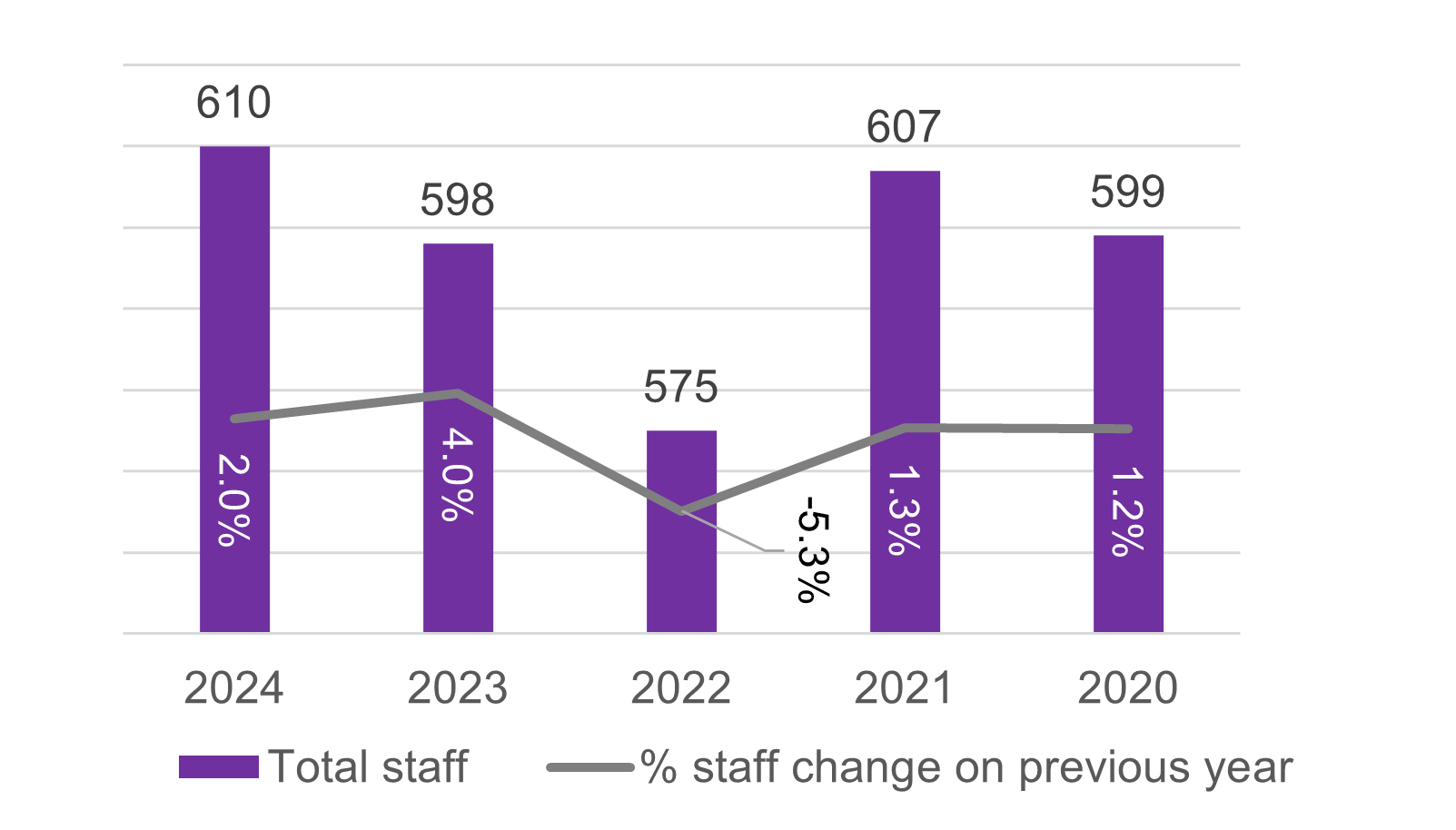
Working Pattern (Full time/part time)
Part-time staff account for 16.6% of all staff, which is a 3.3% decrease in the proportion from the prior year (19.9%).
When considered in terms of gender, however, it is notable that the proportion of men working part time hours has seen another further decrease on the relatively significant decrease reflected in the prior year (from 13% to 11.8%, and this year to 8.7%).
The proportion of women working part time has also decreased (slightly more significantly than men (from 25.9% to 22.6%). Both rates of decrease equate to circa 3% reduction.
Women working part time account for 22.6% of all women in our staff group. In Scotland 38.6% of women in employment work part time. Difference of 16%.
Men working part-time account for 11.8% of all men in our staff group .This is 1.1% less than the proportion of men working part time in Scotland, 12.9%.
At Senior Executive Team level, no-one works part time hours under the Office for National Statistics (ONS) definition. Part-time working is defined as working 30 hours or fewer per week.
Difference – 2022/23 to 2023/24
- men part-time staff – decreased by 7 (from 30 to 23)
- men full-time staff - increased by 18 (from 224 to 242)
- women part-time staff – decreased by 11 (from 89 to 78)
- women full-time staff - increased by 12 (from 255 to 267)
It should be noted for context that the overall headcount has increased with some degree of significance on the above figures (from 598 to 610, increase of 2%) over the period in question, with a particular increase this year in the headcount for men (from 254 to 265).
Disabled staff are more likely to work part- time than the whole staff group (18.6% compared to 16.6%) this year.
Minority Ethnic (ME) staff are much less likely to work part-time (5.3%) than White colleagues (15.5%). This figure is however significantly limited by the available data concerning the ethnicity of our staff group.
LGB+ staff are slightly less likely to work part-time contracts (14%) than the whole staff group (16.6%).
This overall reduction in the proportion of our staff working part-time may be attributed to changes in our ways of working following the Covid-19 pandemic. We implemented a New Ways of Working programme which enabled people and teams to work flexibly, including hybrid We will continue to monitor for the impact on specific groups.
Sex
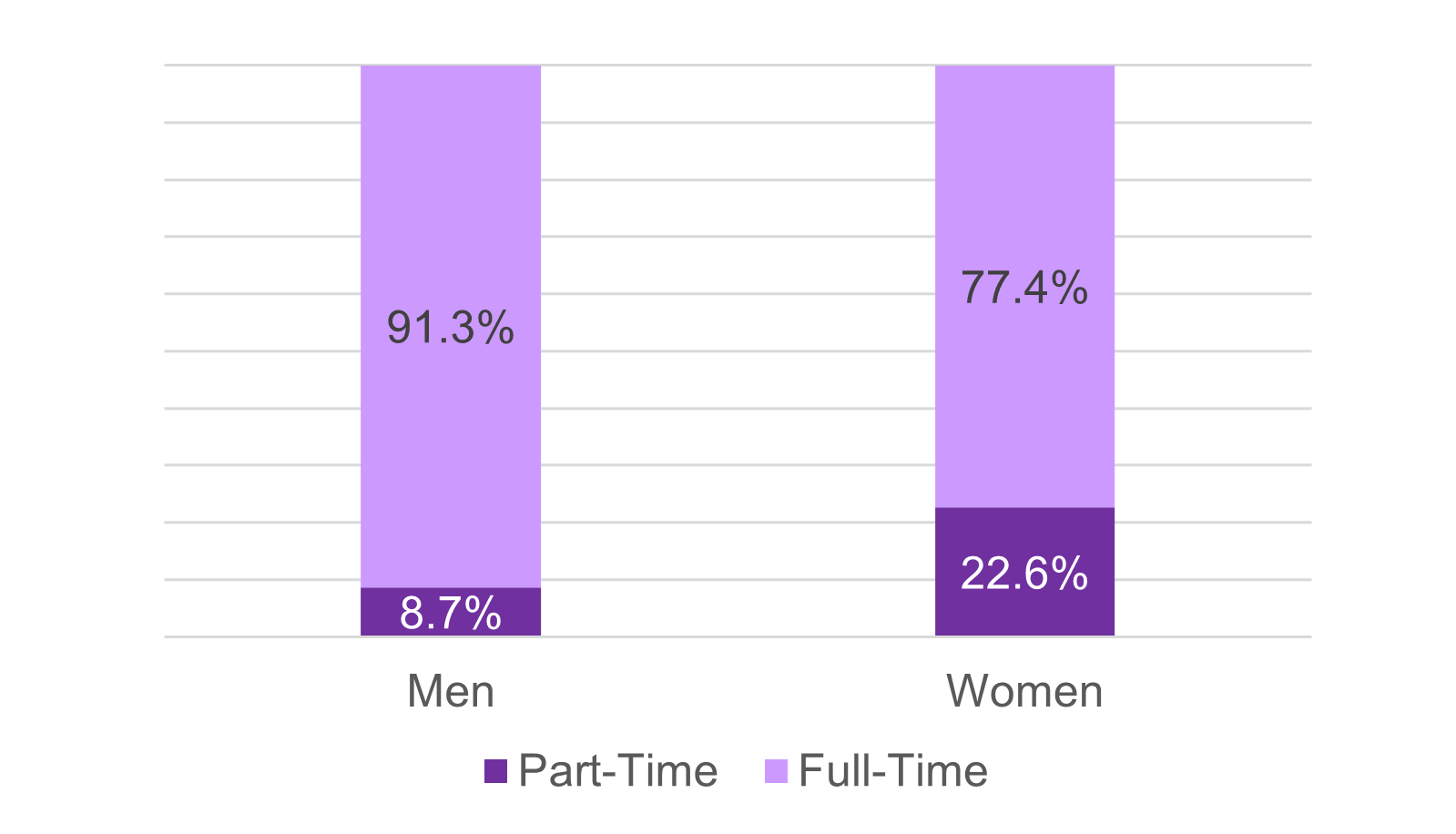
Disability
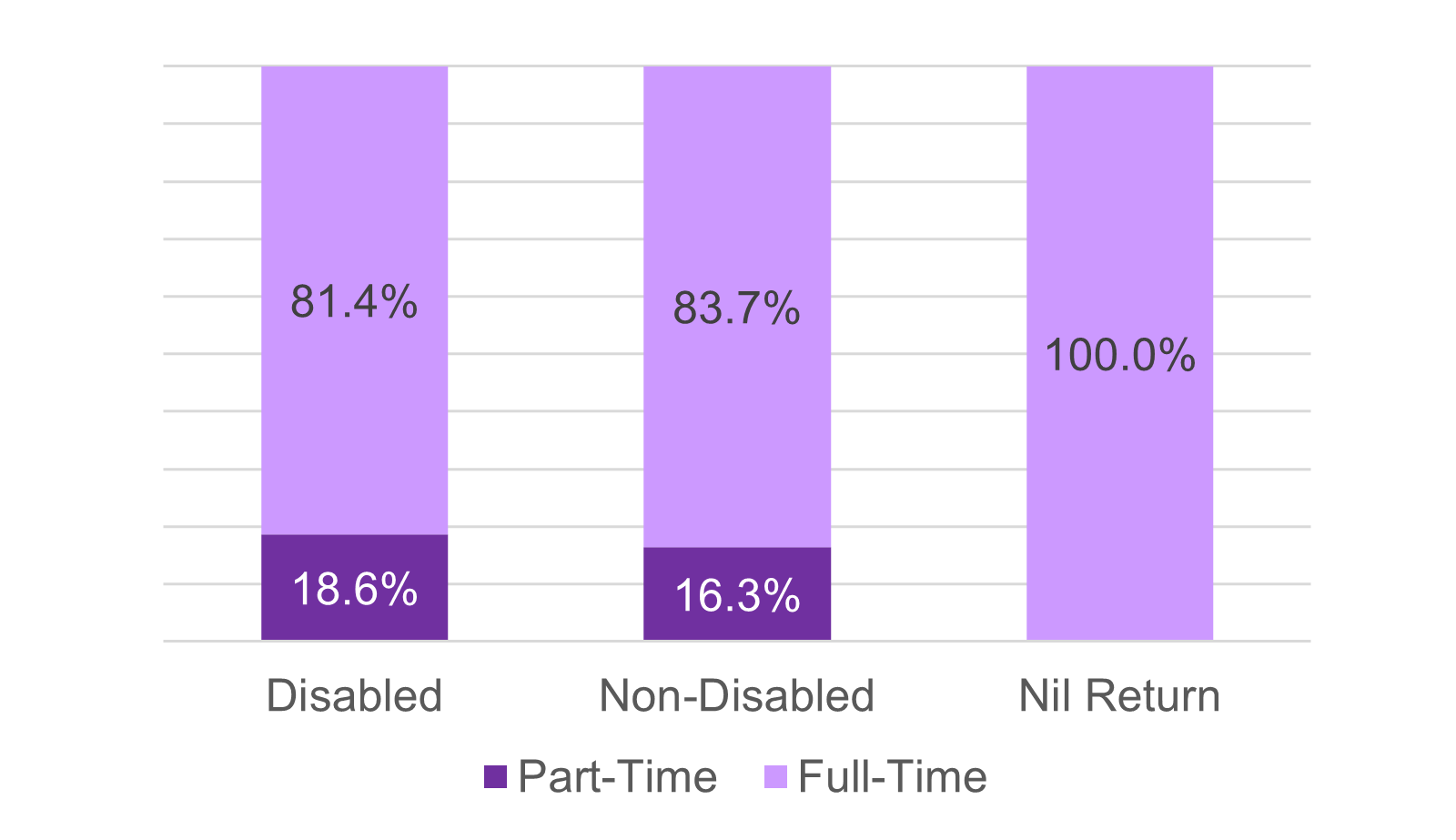
Ethnicity
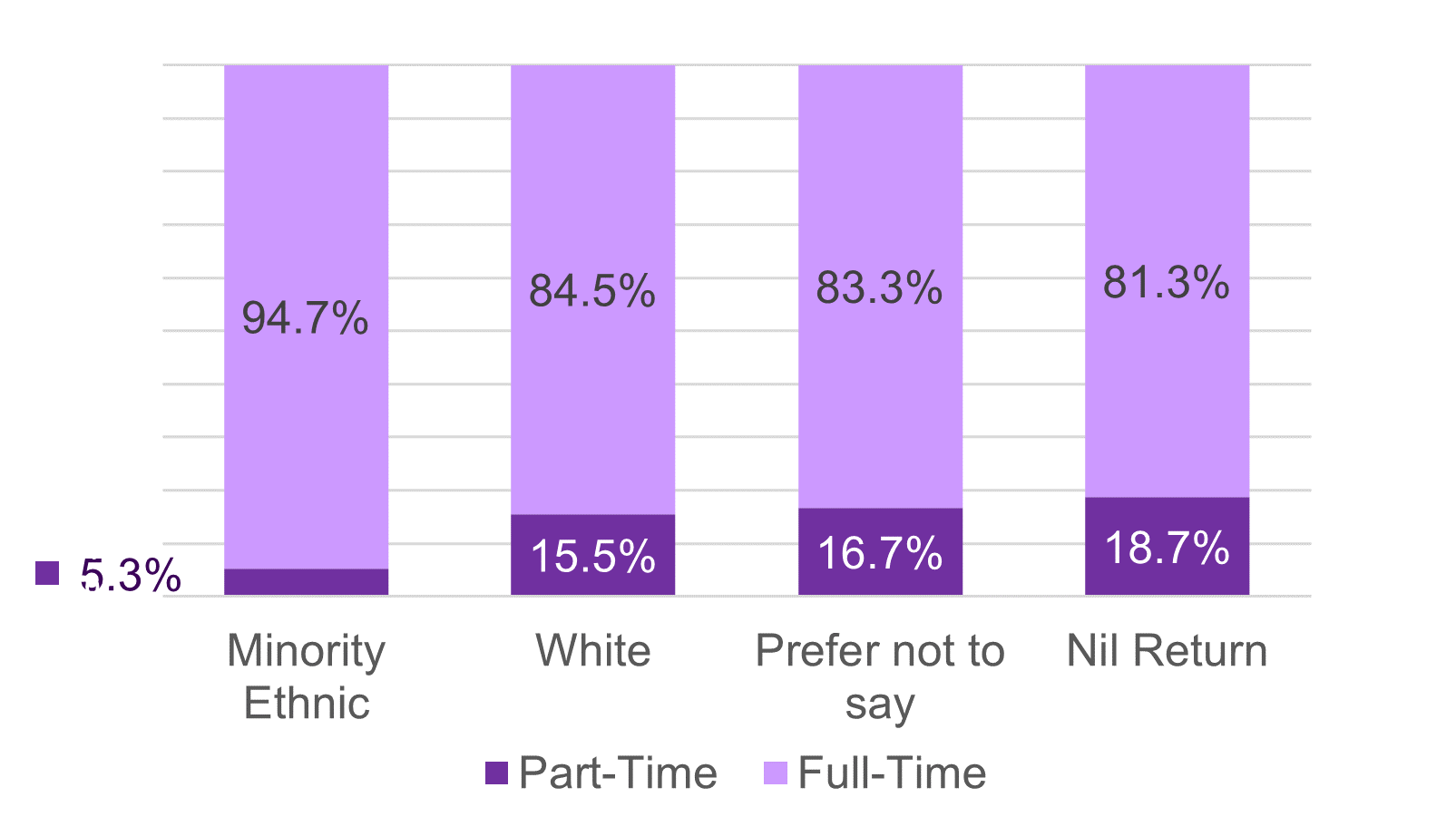
Sexual orientation (LGB+)
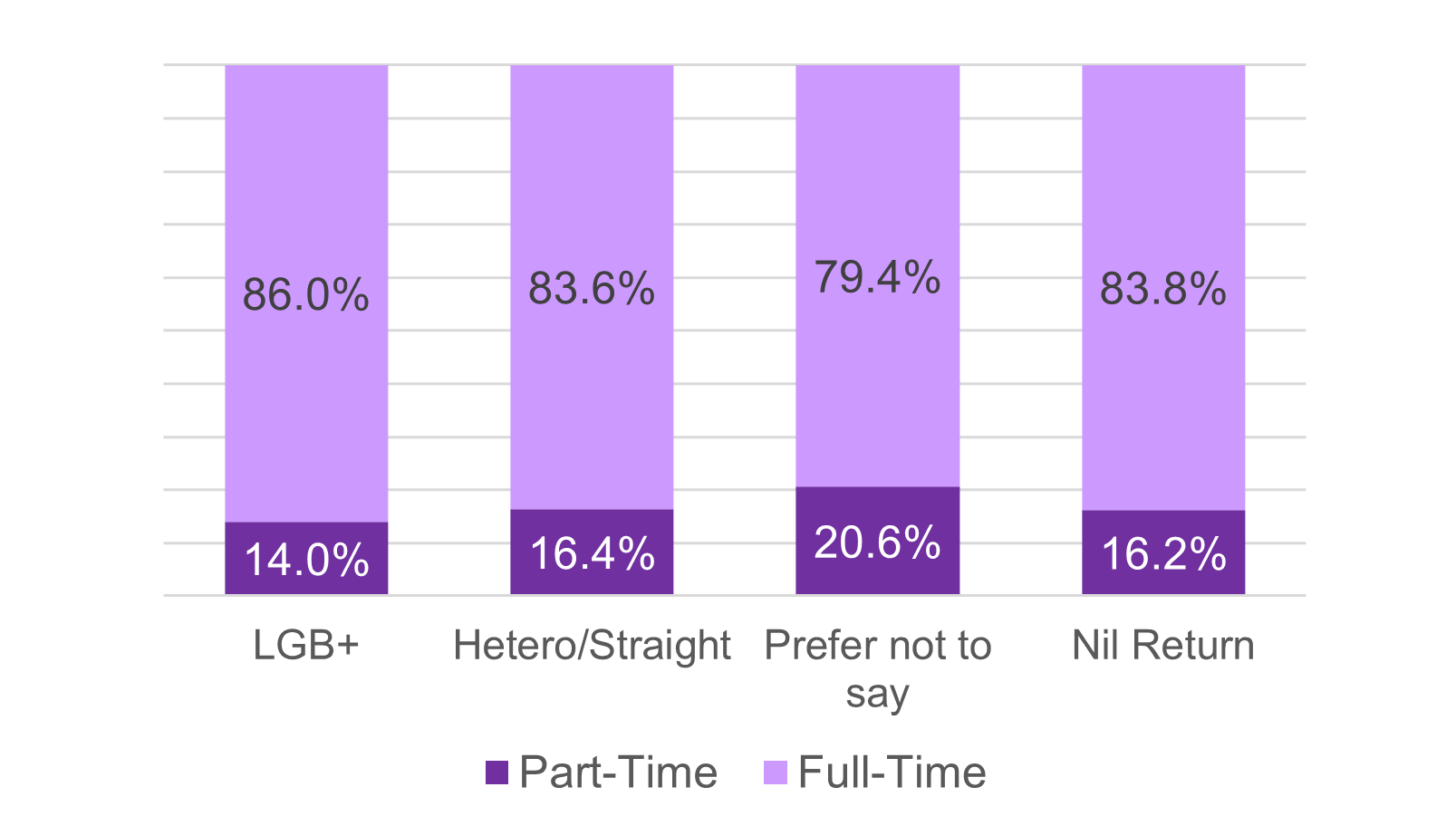
Sex

The number of women in our staff group increased from 344 to 345, increase of 0.3% on the previous year. The proportion of women in our staff group decreased by 1% to 57%. When compared to Scottish population data this is an over-representation of 6% within the 16 to 64 years age group. The proportion of women in our leadership team is 67% (previously 70%) This percentage change is attributed to the reduction in size of our leadership team from 10 to 6 people. The rate in increase of the headcount for men over the period was 4.3% (from 254 to 265).
Senior Executive Team (Grade 8 and above)
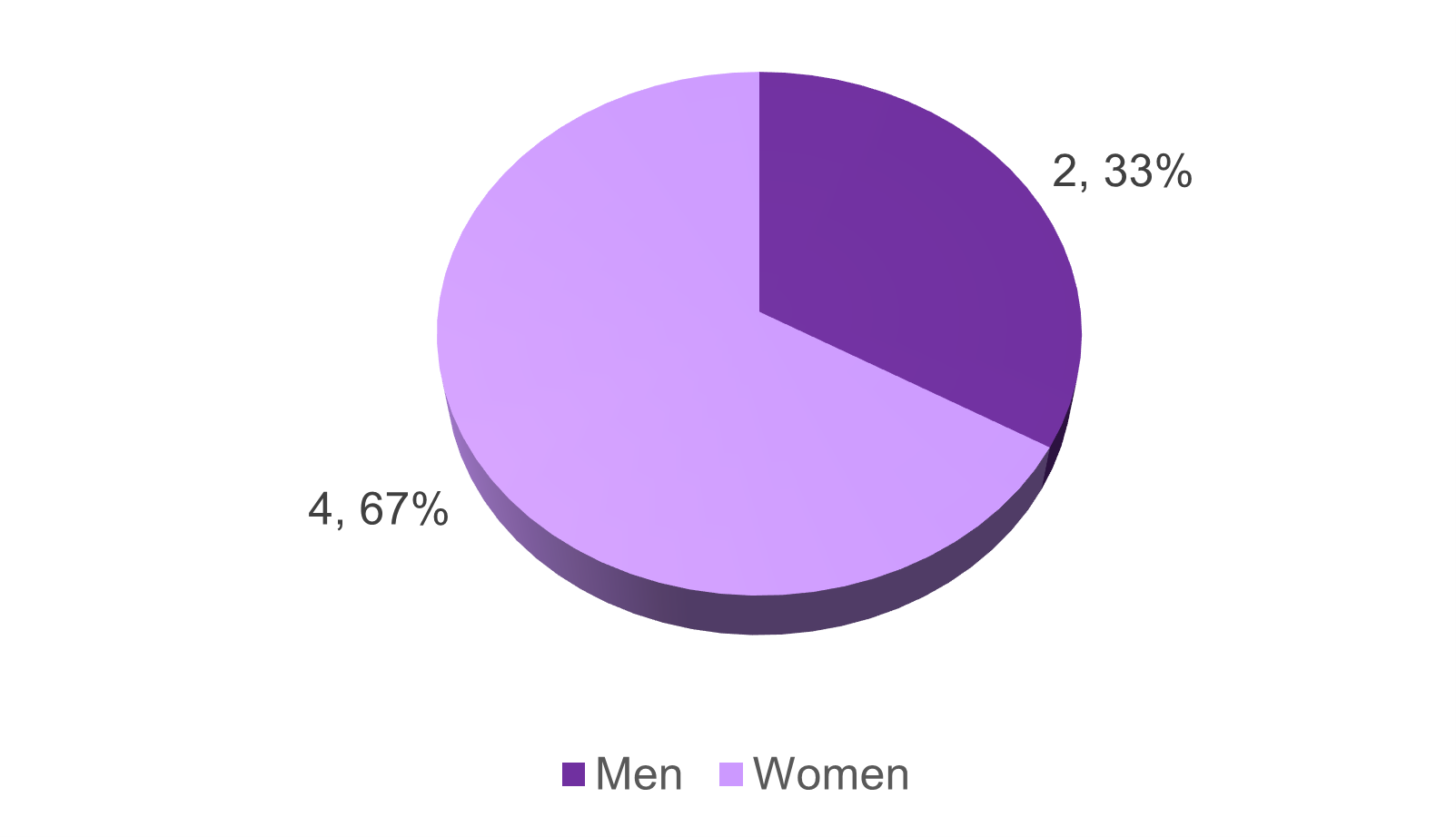
Senior managers (Grade 6 and above)

Gender Identification
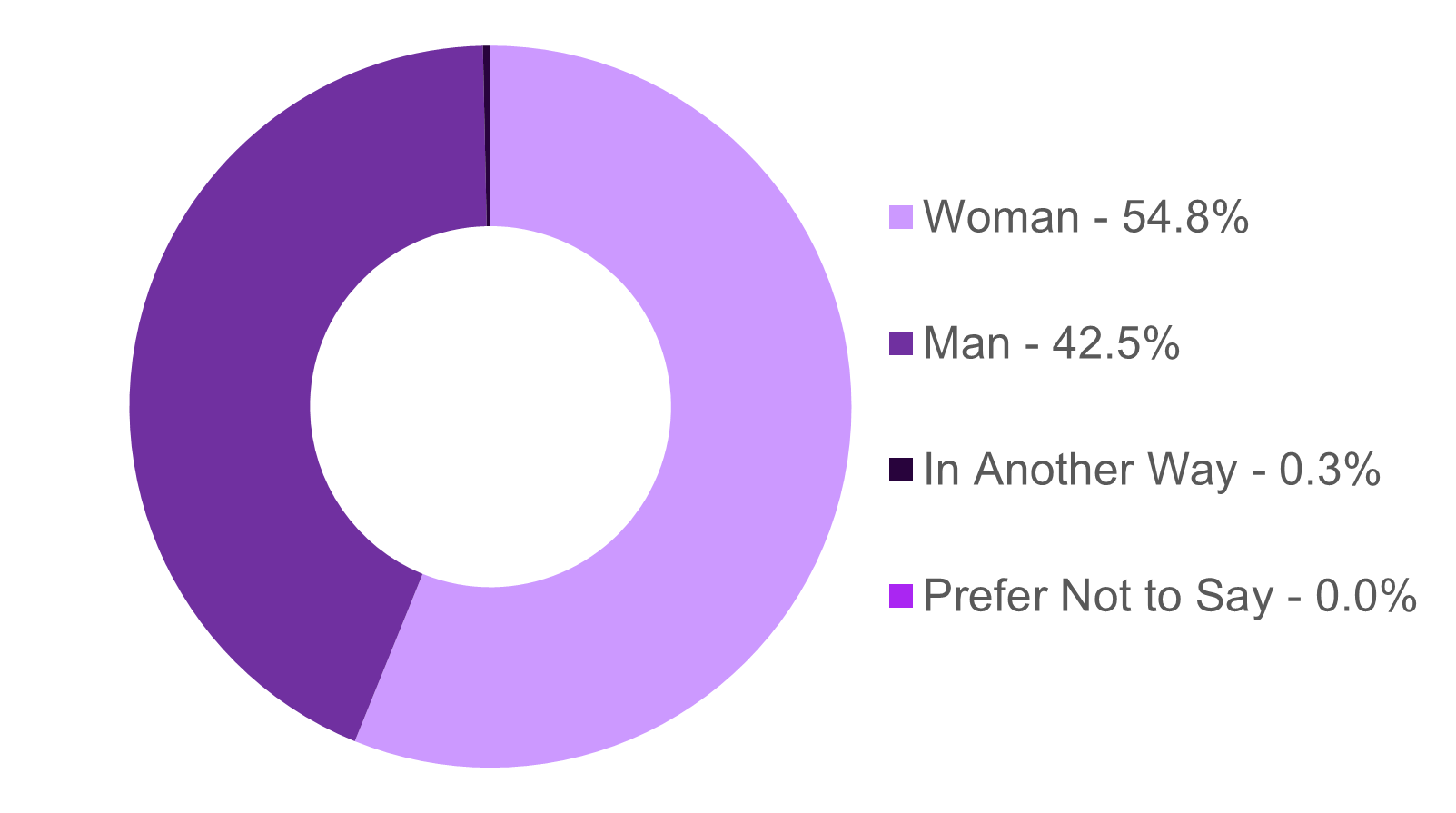
In this reporting year there have been responses where staff members have described their gender identification as ‘in another way’ to either man or woman or identified as non-binary.
Non-binary

Trans
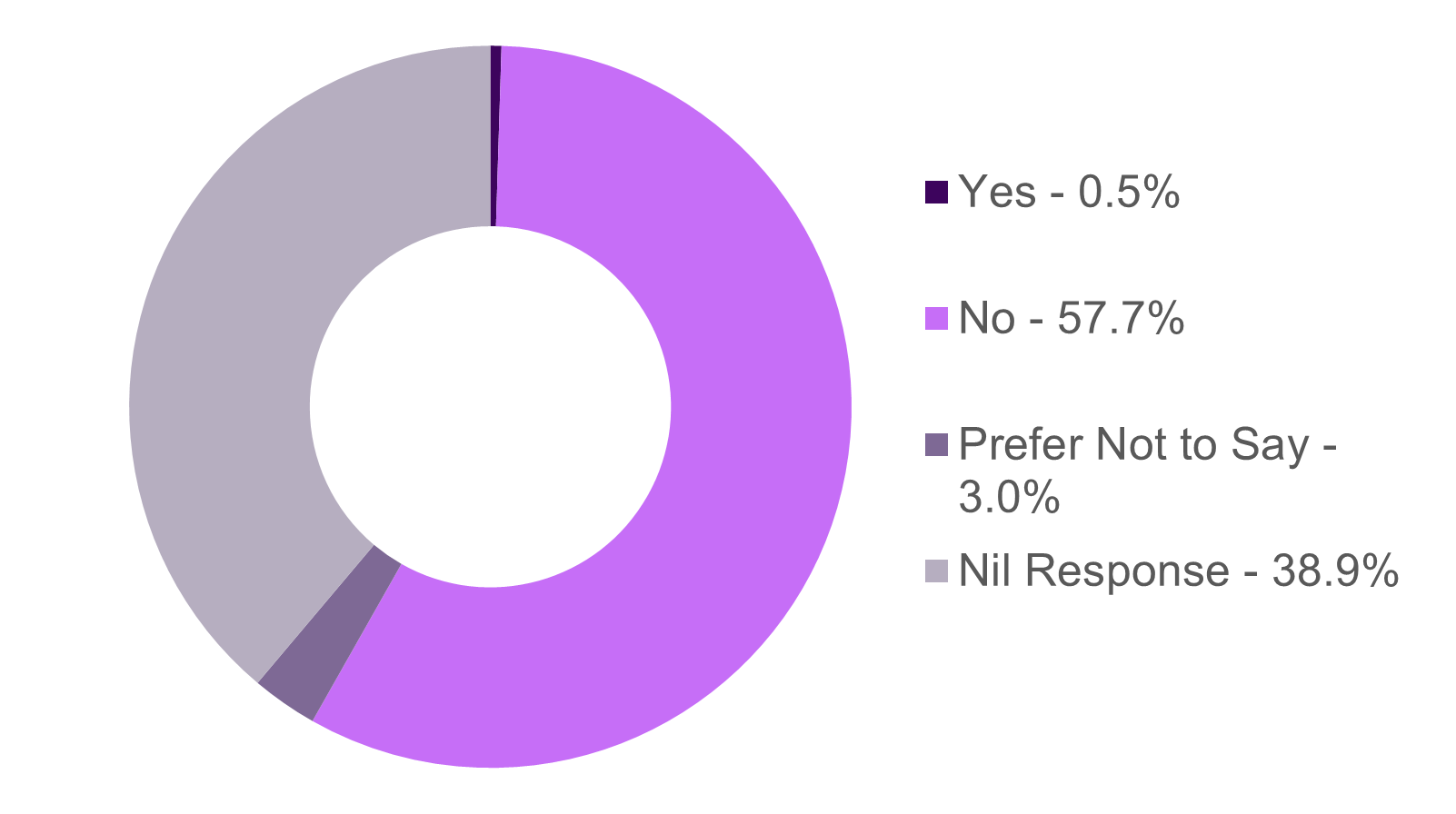
Sexual orientation (LGB+)
.png)
The number of Lesbian, Gay, Bisexual, + (LGB+) people in the staff group has increased this year from 39 to 50 people. This changes the representation in our staff group from 6.5% to 8.2%. The number of staff declaring as trans has also increased with representation increasing from 0.2% to 0.5%.
Ethnicity
.png)
The number of people describing themselves as ME decreased from 33 to 19. Decreasing the representation in the staff group from 5.5% to 3.1%.
The decrease is due to a problem with the system that collected our data during the reporting year. We have since implemented a new system and we are engaging with our staff group to improve the data set to present a more accurate demonstration of the representation of the number of Minority Ethnic people in our staff group.
Disability
.png)
A system change after the 2021/22 reporting year means that nil- responses are counted as ‘No’.
70 people declared a disability this year (previously 56). The representation in the staff group increased by 1.8% from 9.7% to 11.5%.
Age
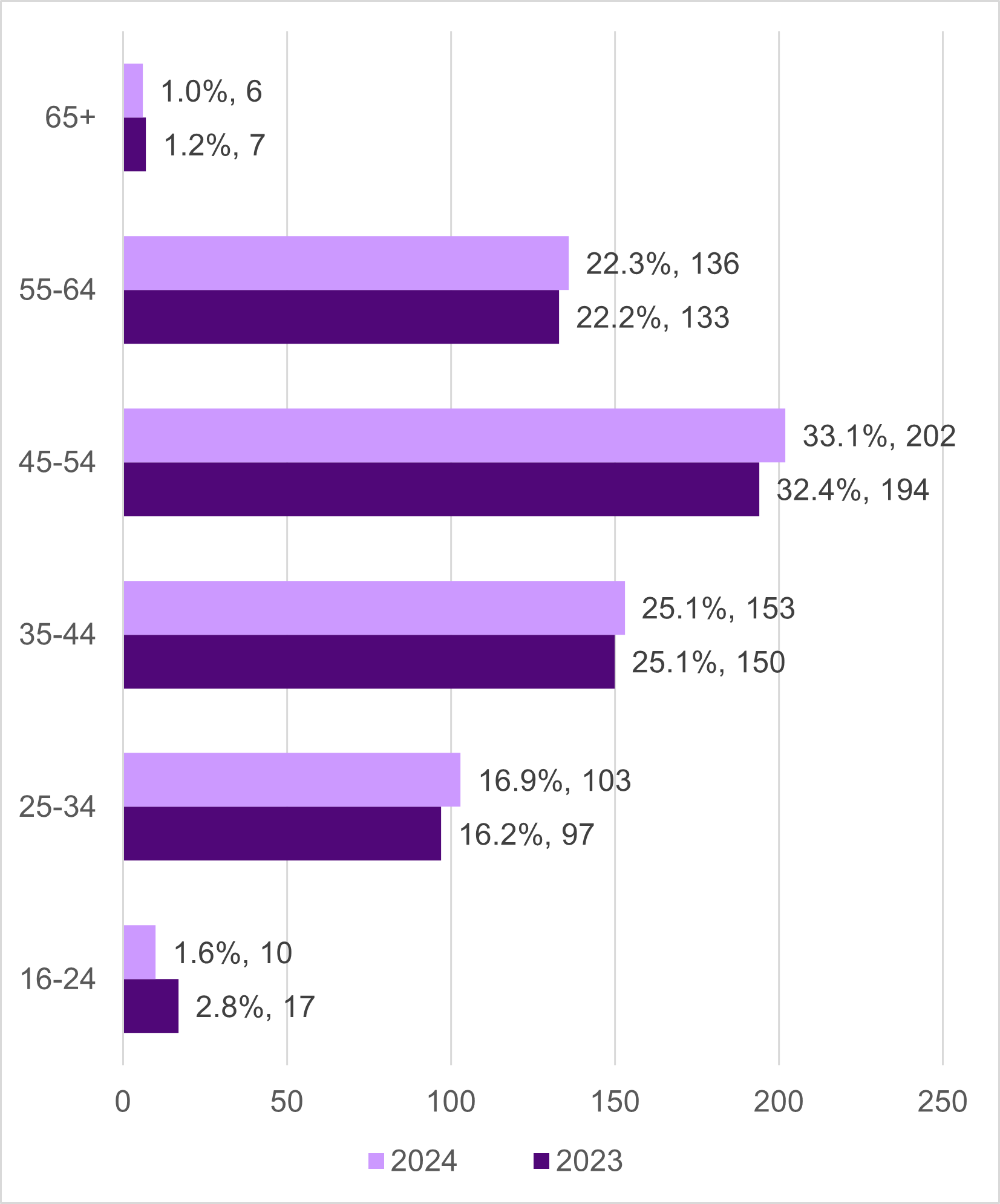
The median age this year changed from 46 years to 47 years. The number of young people (16 to 24 years old) in our staff group decreased to 10 from 17 the previous year. This was a decrease of 41%, the greatest percentage change for any age group. The 45 to 54 year old age group had the greatest percentage increase (4.1%) from the previous year.
Religion or Belief
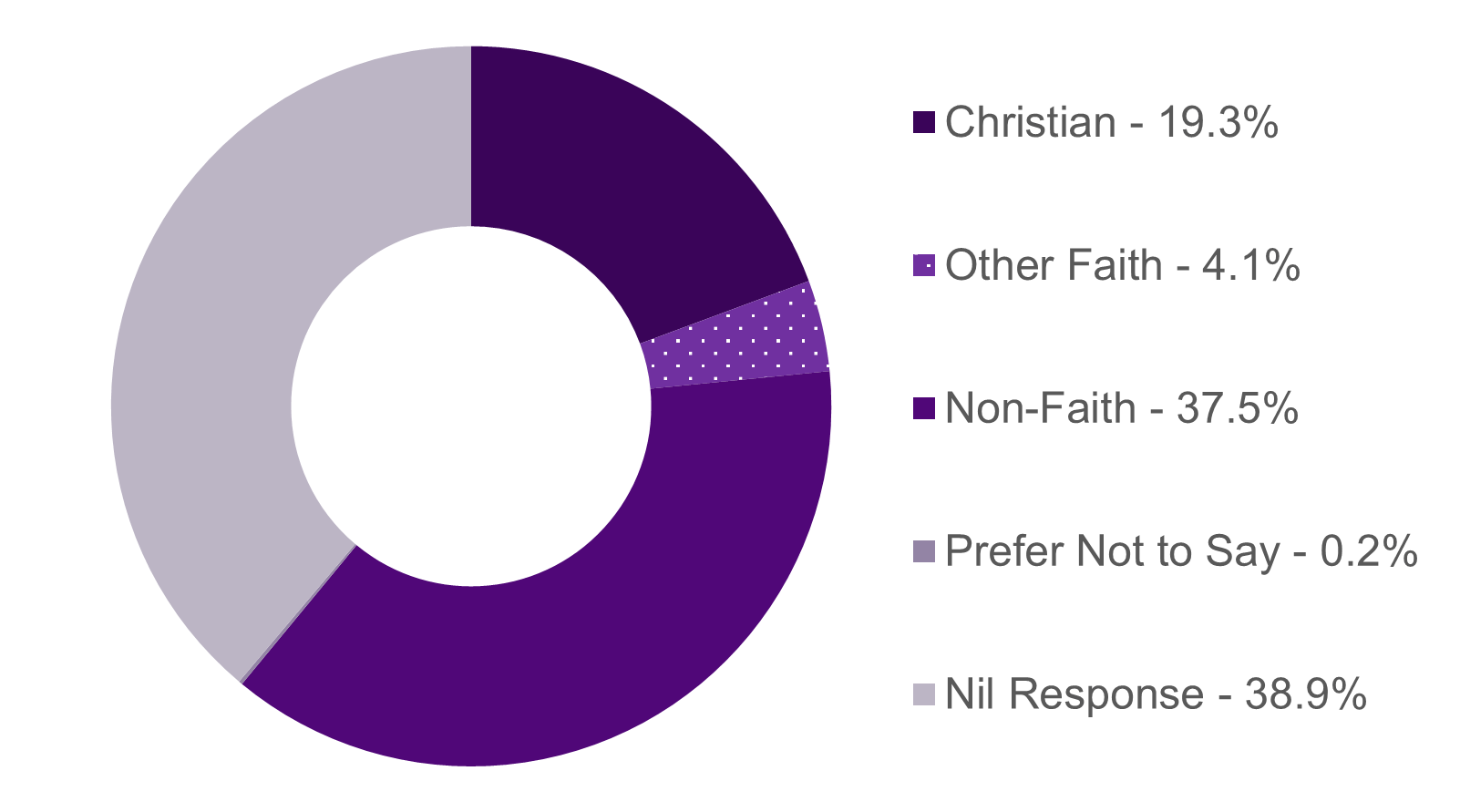
The proportion of staff declaring a religion or belief decreased by 2.2% to 23.4% from 25.6% in the previous year. In this year there was a significant reduction in the response rate to this question from 73.4% to 61.1%. The number of people declaring a religion decreased from 153 to 143. There was a greater reduction in those declaring a Christian faith (7%) than Other Faiths (3.8%).
Pregnancy and Maternity
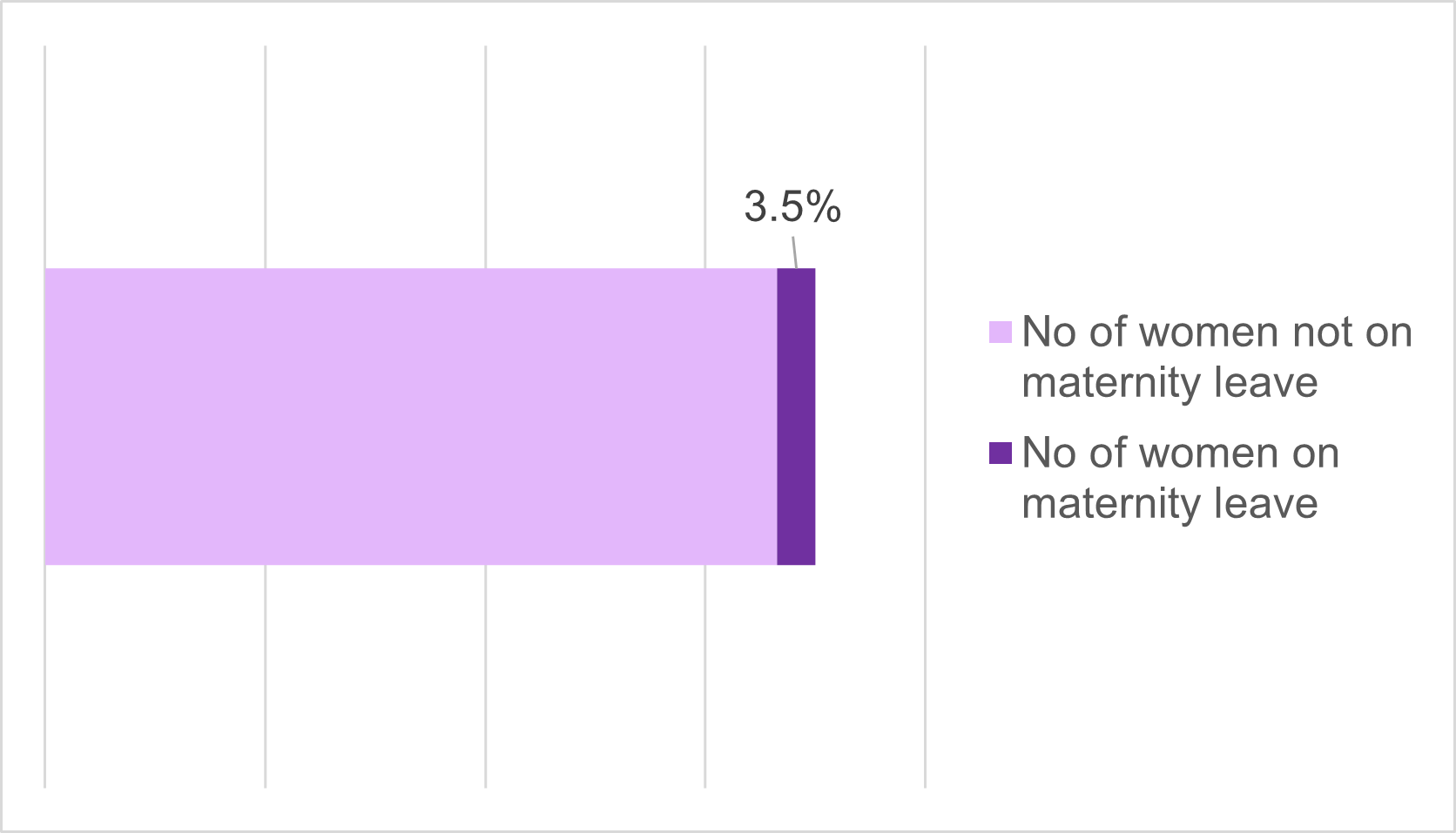
Return to Work and Working Pattern
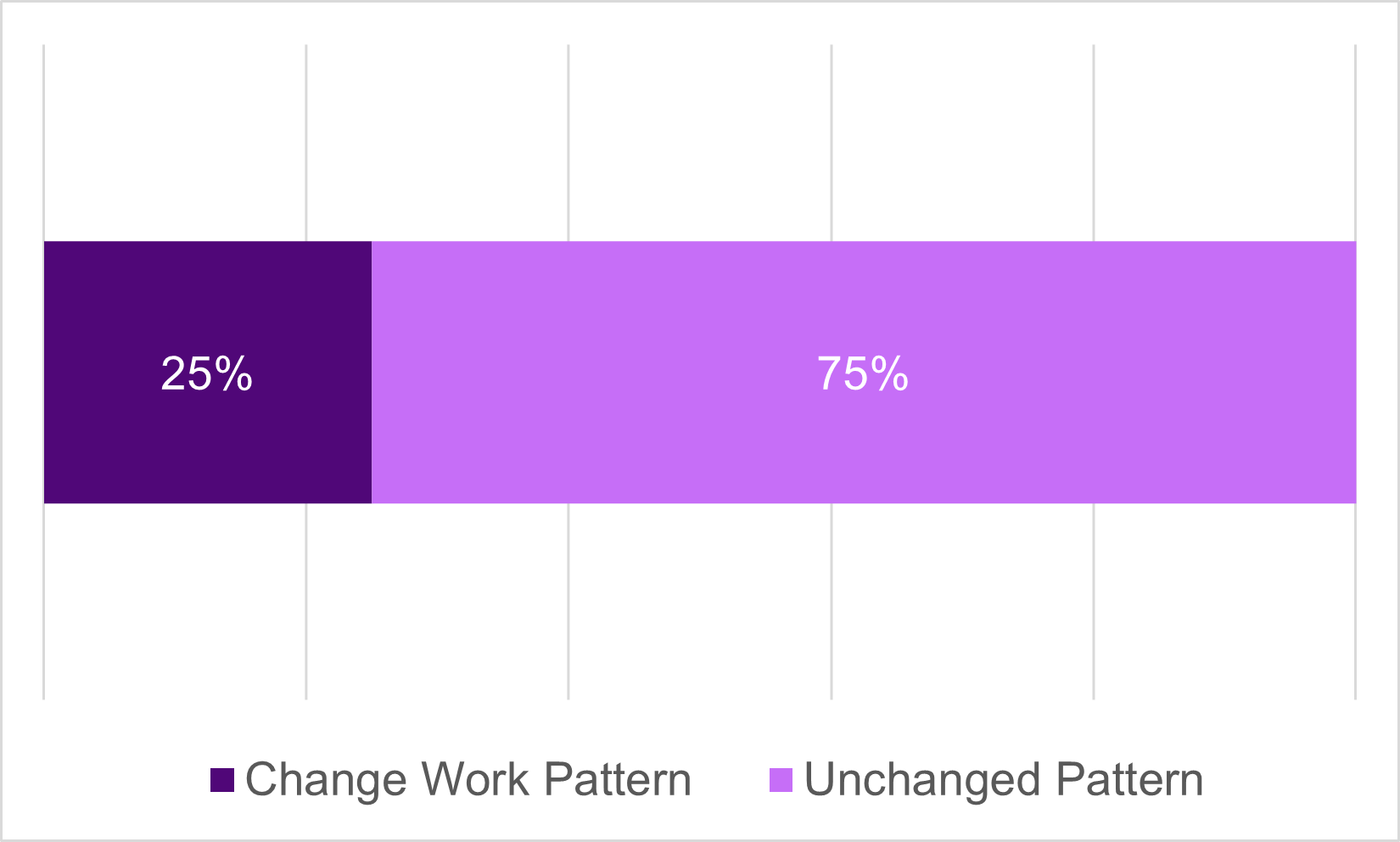
Paternity Leave
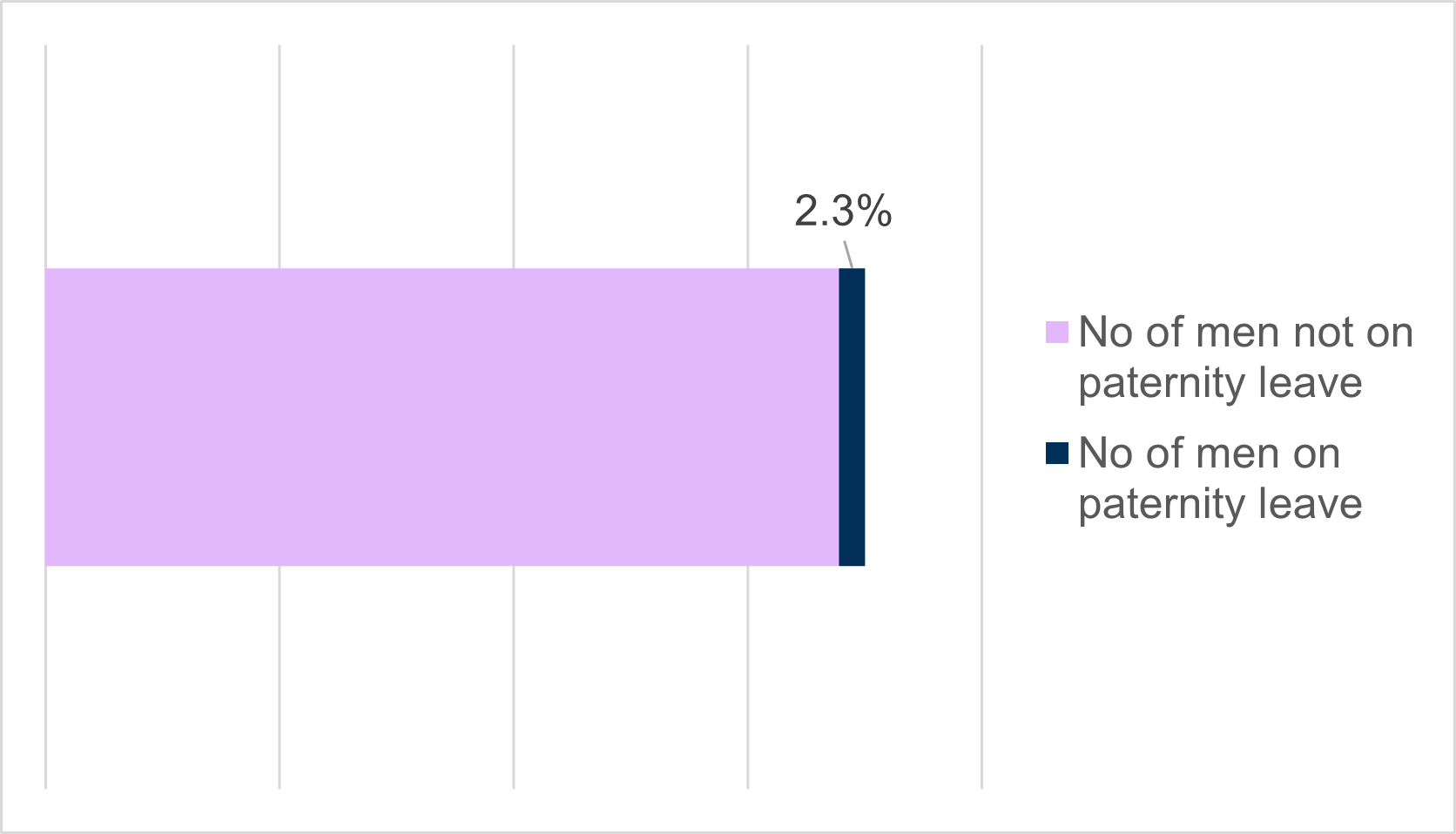
Shared Parental Leave
| Total no. of staff | No. of staff on SPL | %age of staff on SPL | |
|---|---|---|---|
| Women | 345 | 1 | 0.3% |
| Men | 265 | 2 | 0.8% |
How do we compare?
For comparative purposes we have used the data released from the Scottish Census 2022.
We include the following White groups as minority ethnic groups – Polish, Gypsy / Traveller, Roma and Showman / Showwoman.
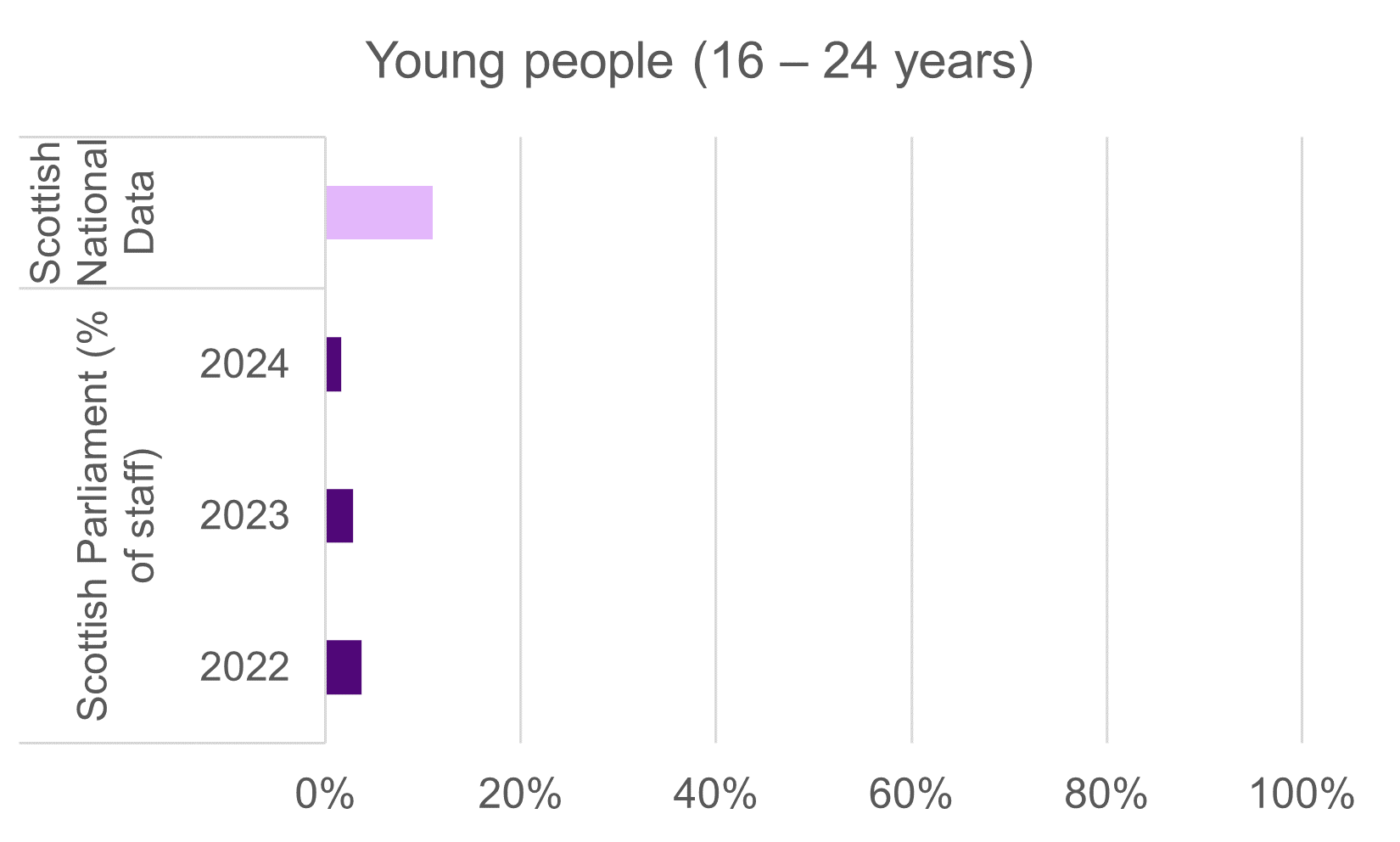
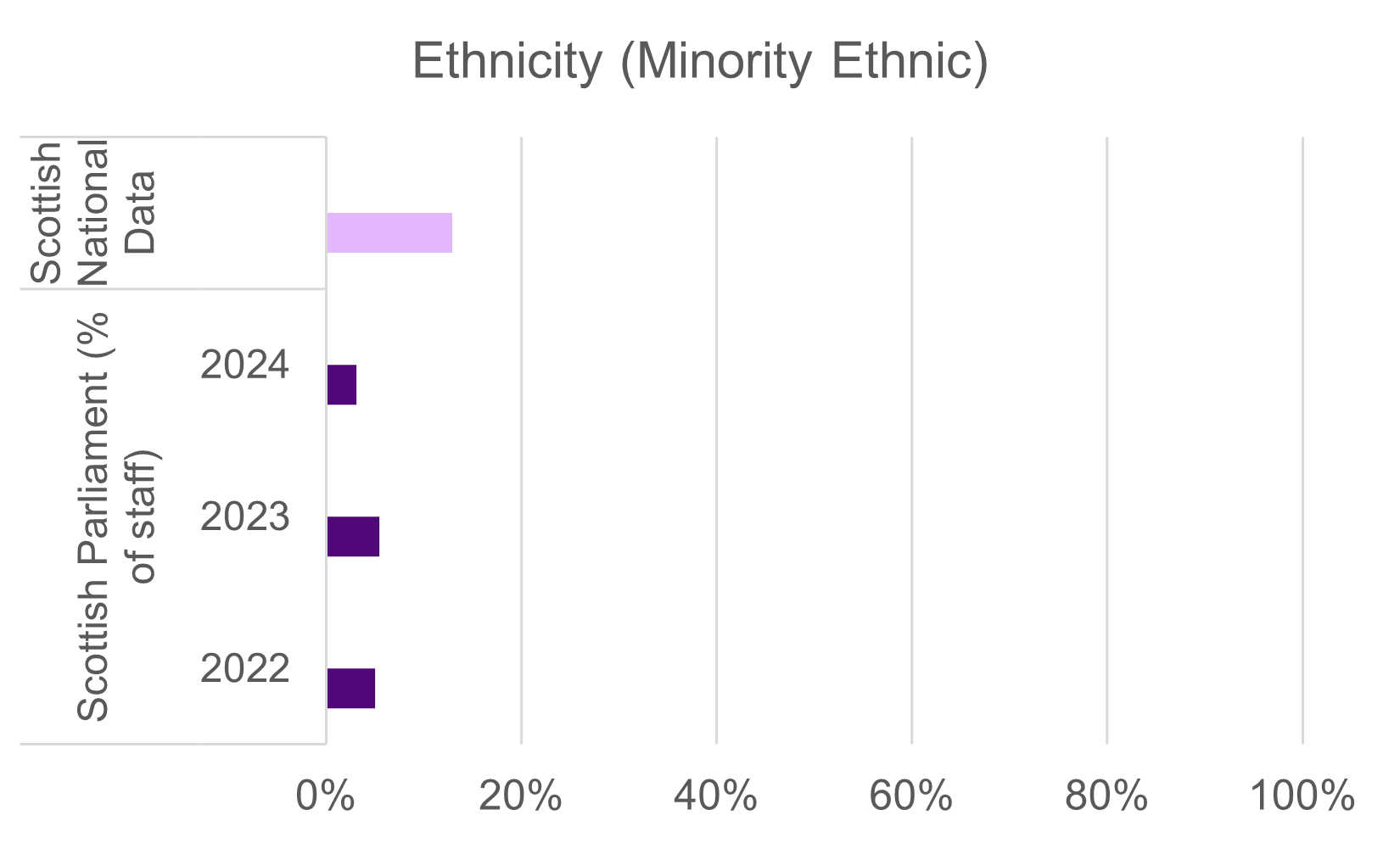
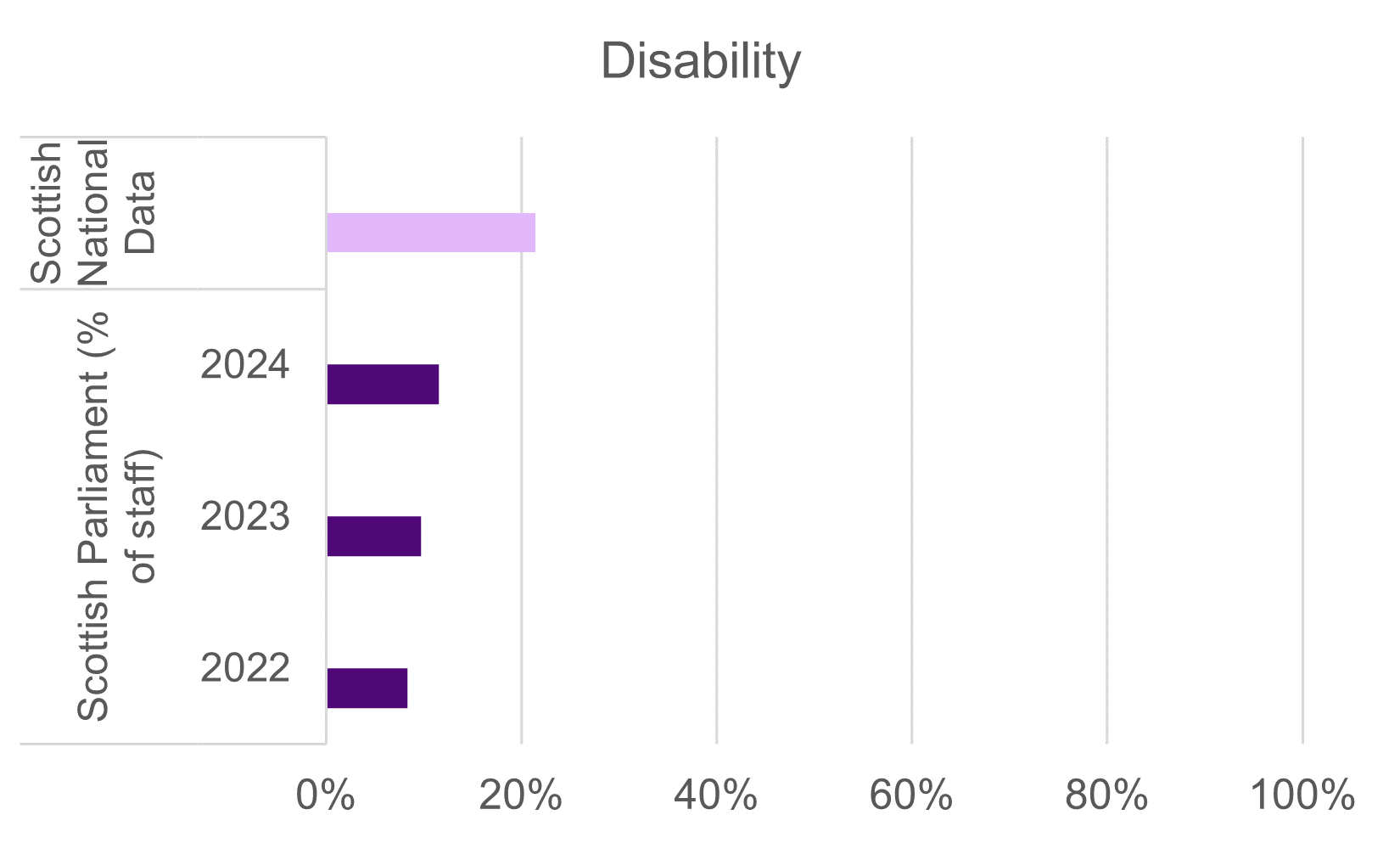
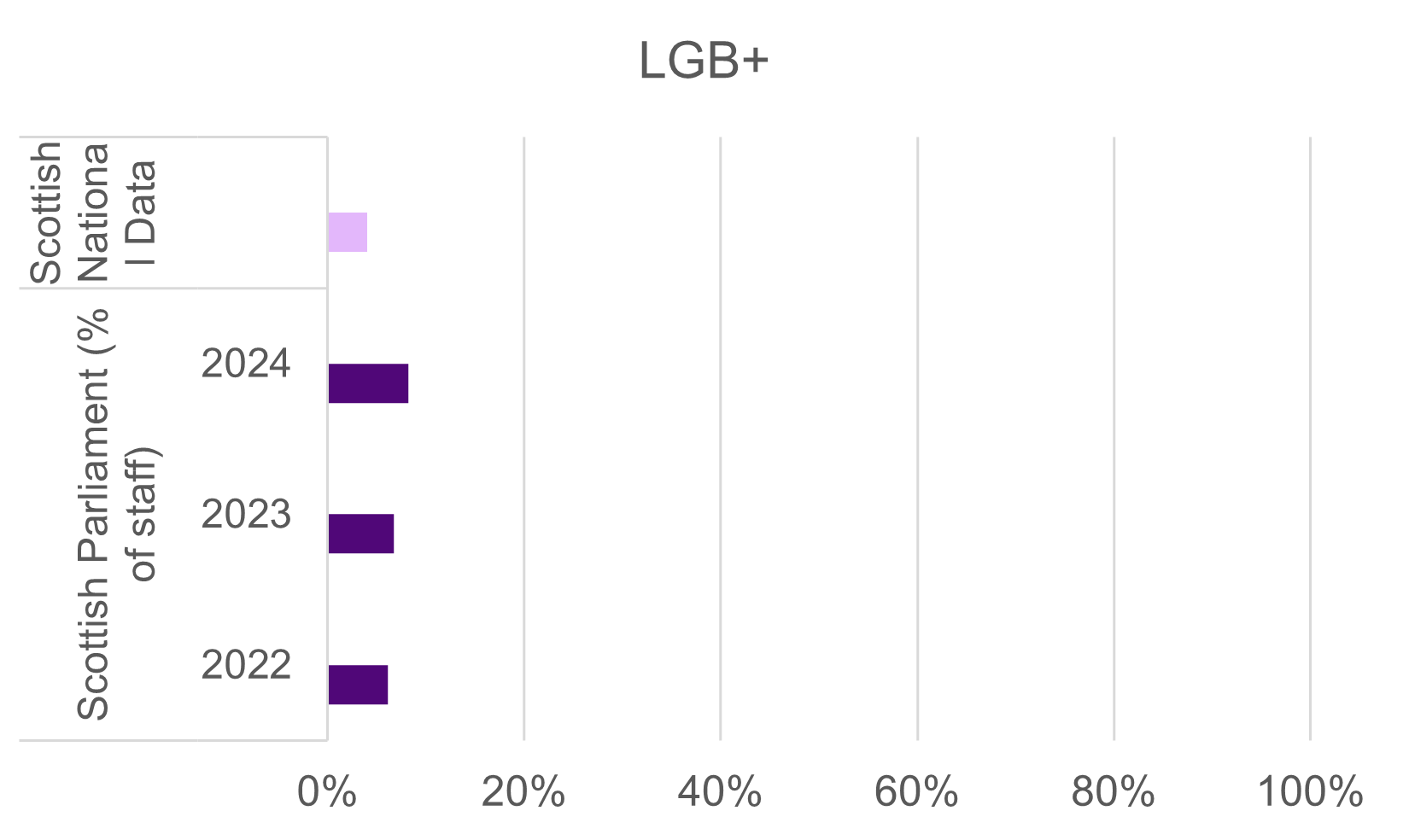
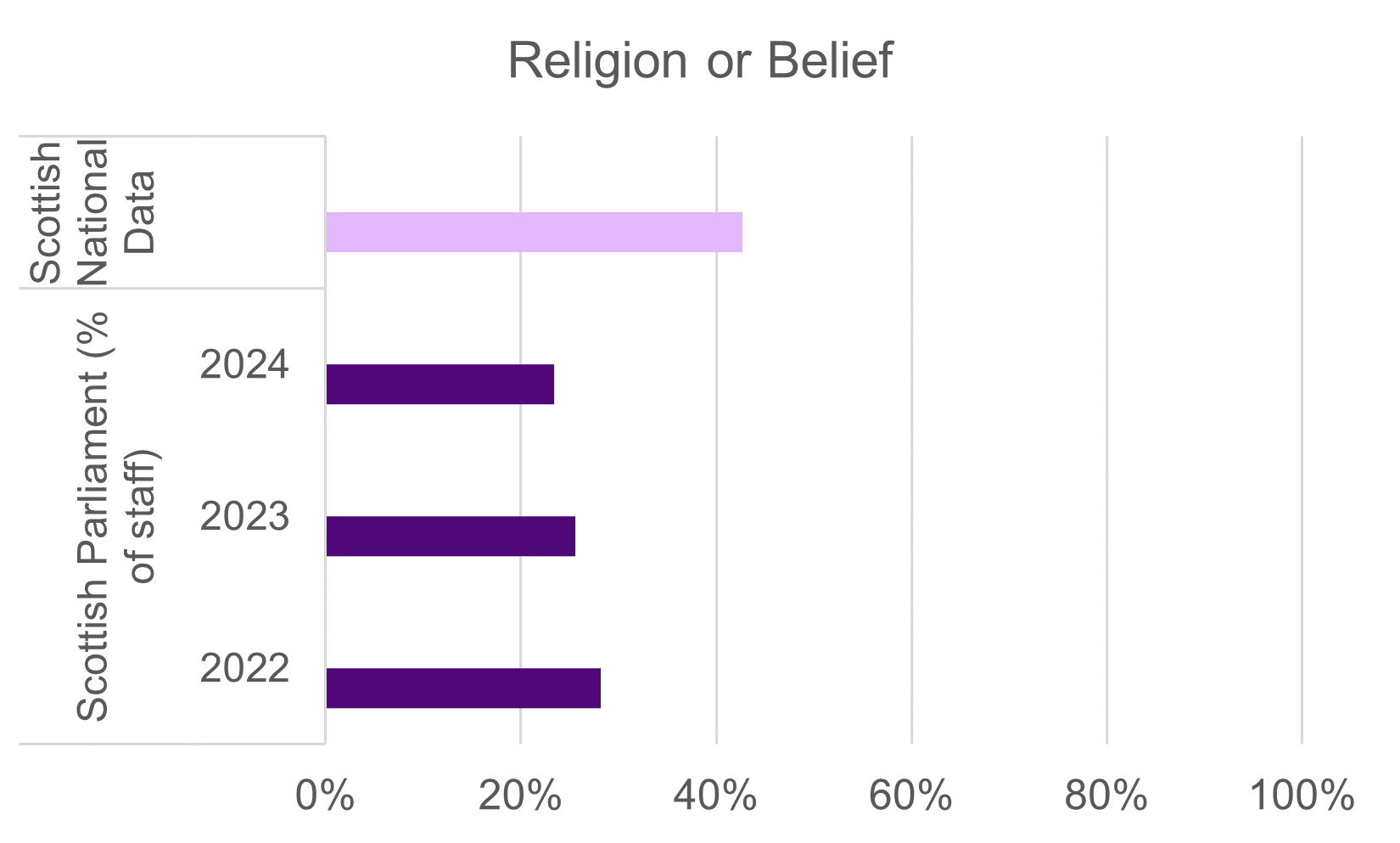

Recruiting a diverse workforce
Recruiting a diverse workforce
Data tables available for download here (82KB Excel document)
Our aim is to have a staff group that is representative of the people of Scotland. We use positive action to help us attract candidates from groups that are under-represented in our workforce. We analyse our recruitment data to review the effectiveness of the actions we have taken and to understand where there may be barriers.
- During the period, there were 69 appointments made. This is a decrease of 36% on the previous year (107 appointments)
- Overall, there were 1111 applications for posts during the period. This is a 19% decrease from the previous reporting year (1370 applications). There was an average of 16.1 applications per post compared to 12.8 applications per post in the previous year. An increase of 25.8% per post.
- In the reporting year there was a 14% increase in the proportion of roles advertised externally (from 56% to 64%). These are roles to which internal and external applicants can both apply.
Annual changes
| 2023/24 | 2022/23 | 2021/22 | |
|---|---|---|---|
| Total number of applications | 1111 | 1370 | 490 |
| Number of appointments made | 69 | 107 | 62 |
| % of appointments to men | 43.5% | 39% | 31% |
| % of appointments to women | 53.6% | 59% | 66% |
| % of appointments to in another way candidates | 1.4% | 1% | 0% |
| % of appointments to minority ethnic candidates | 14.5% | 14% | 11% |
| % of appointments to white candidates | 84.1% | 84% | 84% |
| % of appointments to disabled candidates | 8.7% | 8% | 11% |
| % of appointments to non-disabled candidates | 89.9% | 88% | 87% |
| % of appointments to LGB+ candidates | 13.0% | 17% | 19% |
| % of appointments to heterosexual candidates | 84.1% | 76% | 69% |
Sex and gender identification
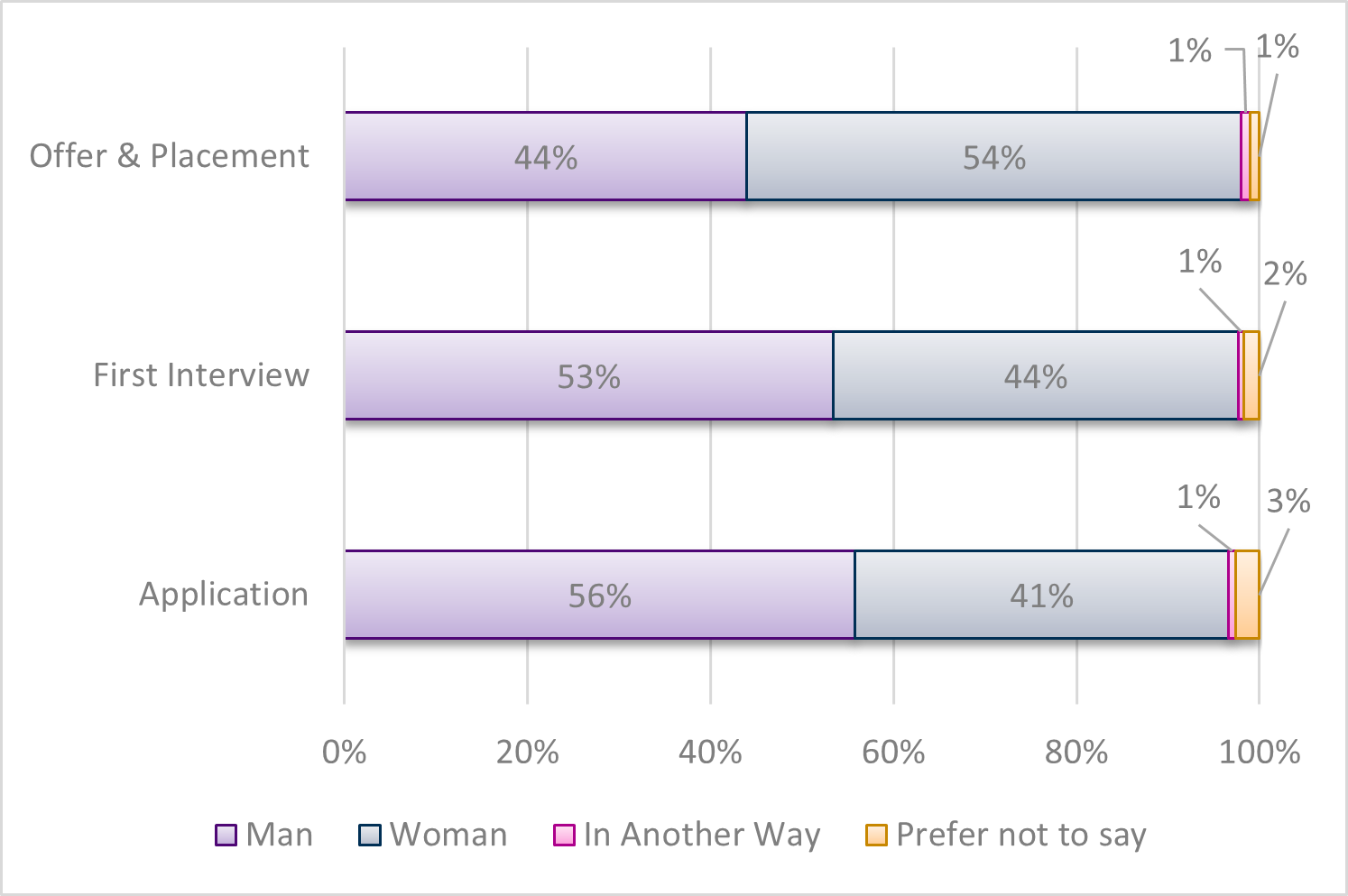
- The number of applications submitted from women decreased this year (41%), compared to last year (50%)
- Nearly 1% of applications were from people who described their gender as In Another Way
- The success rate at appointment for women was 8% compared to 9% last year
- For men the success rate was 5%, staying the same as last year (5%)
Ethnicity
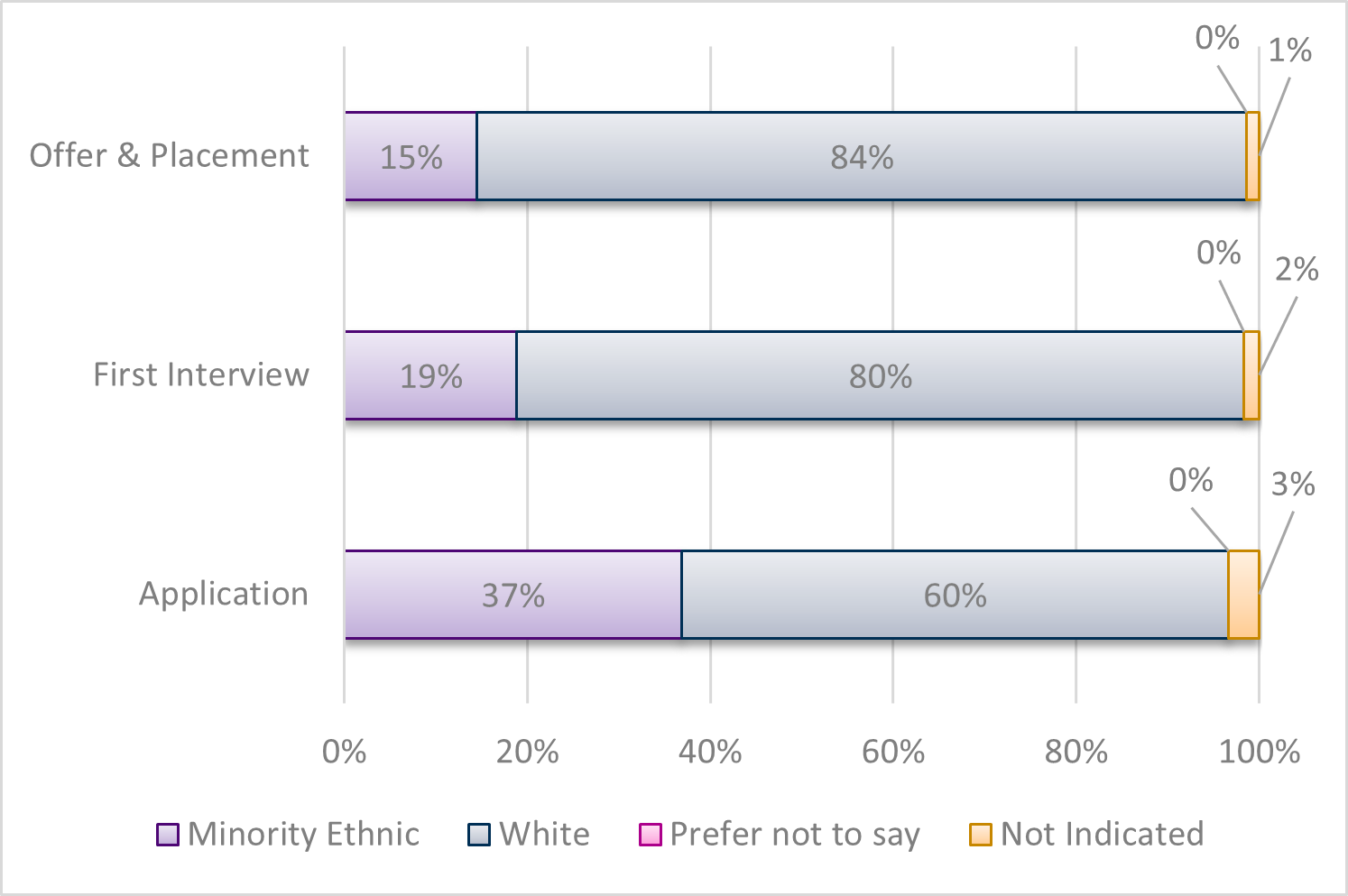
- The proportion of applications from Minority Ethnic (ME) candidates increased again this year to 37%, a 15% increase from the previous year (22%)
- The proportion of all appointments to ME candidates increased to 14.5% compared to 14% in the previous year.
- The success rate at appointment for ME candidates decreased this year to 2% compared to the previous year (5%)
- The success rate for White candidates stayed the same as the previous year at 9%
- The success rate for candidates who did not declare their ethnicity was 2%, a 31% decrease compared to the previous year (33%)
Disability

- The proportion of applications from disabled candidates increased to 11%. This was a 1.7% increase from the previous year (9.3%)
- The success rate at appointment for disabled candidates was 5%, compared to 6.5% for non-disabled candidates. In the previous reporting year, the success rate for disabled candidates was 7% and 8% for non-disabled candidates.
- The difference in the success rate between disabled candidates and non-disabled candidates was 1.5%. This was a 0.5% decrease from the previous year (1%)
- The success rate for candidates who preferred not to declare whether they had a disability was 3%
Sexual Orientation

- Applications from Lesbian, Gay, Bisexual, + (LGB+) people decreased from the previous year (12% from 13%)
- The success rate at appointment for LGB+ candidates was the same as heterosexual candidates at 6.6%. In the previous year the success rate at appointment for LGB+ candidates was 9% compared to 8% for Heterosexual candidates.
- The proportion of appointments to LGB+ people decreased from the previous year (17% to 13%)
Intersectional analysis
| Ethnicity/sex | No of applications | % of applications | First interview | % of first interviews | Success rate | Offer and placement | % of offers | Success rate | Success rate overall | Census rate |
|---|---|---|---|---|---|---|---|---|---|---|
| Minority ethnic woman | 146 | 13.2% | 18 | 10.6% | 12.3% | 4 | 5.9% | 3% | 0.4% | 12.9% |
| Minority ethnic man | £16.12 | 23.3% | 15 | 8.8% | 5.8% | 6 | 8.8% | 2% | 0.5% | 12.9% |
| Minority ethnic in another way | 2 | 0.2% |
0 | 0.0% | 0.0% | 0 | 0.0% | 0% | 0.0% | |
| White woman | 302 | 27.2% | 59 | 34.7% | 19.5% | 33 | 48.5% | 11% | 3.0% | |
| White man | 346 |
31.2% | 77 | 45.3% | 22.3% | 24 | 35.3% | 7% | 2.2% | |
| White in another way | 7 | 0.6% |
1 | 0.6% | 14.3% | 1 | 1.5% | 14% | 0.1% | |
| Totals | 1110 | 100% | 170 | 100% | 68 | 100% |
- Reviewing the applicant summary data in comparison to the Scotland Census 2022 data we can see that Minority Ethnic groups are applying at rates proportional to, or higher than their representation in the Scottish population
- The success rate of Minority Ethnic applicants at various stages of the recruitment process is significantly lower compared to white applicants
- Minority Ethnic men have a higher application rate compared to the overall population percentage of Minority Ethnic groups in Scotland
- From our data we can also see that women are more likely to be successful in our recruitment process (54%) compared to men (44%)
- Reviewing this with an intersectional lens, we understand that Minority Ethnic women are less likely to be successful in the labour market than their white counterparts.
- Analysing our recruitment data against these assumptions, we found that this was mirrored in our figures:
- White women have a higher success rate (20%) compared to minority ethnic women (12%) in reaching the interview stage. This indicates that white women are 1.6 times more successful in progressing from the application stage to the interview stage.
- Minority Ethnic women were nearly three times less likely to reach the offer stage (3%) than white women (11%)
- White women are nearly four times more likely to be successful (11%) in our hiring process than Minority Ethnic women (3%)
Diversity pay gaps
Diversity pay gaps
This year, we have reported on the following pay gaps information:
- gender
- ethnicity
- disability
- sexual orientation (LGB+)
Reporting on our diversity pay gaps is important to us in allowing us to identify where we need to improve and to plan accordingly.
Measuring the Ethnicity, Disability and LGB+ pay gaps is limited by the declaration rates from the staff group.
Method of Calculation
For the measures in this report the median and mean hourly rates of pay were calculated. The median pay is the middle point of the population, and the mean pay is the arithmetic average of a population.
Quartiles
This measures the proportion of different groups in each quartile when divided into four groups ordered from lowest to highest pay. This demonstrates whether there is an overrepresentation of one group within lower or higher paid jobs.
This report details the summary findings for the Diversity Pay Gaps 2024 (at milestone date 31 March 2024).
Gender Pay Gap
Gender Pay Gap (GPG)
Data tables available for download here (82KB Excel document)
The Gender Pay Gap is the difference between average hourly earnings (excluding overtime) of men and women as a proportion of average hourly earnings (excluding overtime) of men's earnings.
How do we compare?
The table below provides comparison datasets for UK and Scotland derived from the Office for National Statistics (ONS) annual survey of hours and earnings (ASHE) median pay gap series.
| UK (2024) | Scotland (2024) | Scottish Public Sector (2024) | Scottish Parliament 2024 | |
|---|---|---|---|---|
| GPG - all staff | 13.1% | 9.2% | 8.2% | 0.0% |
| GPG - full-time staff | 7.0% | 2.2% | 2.2% | 0.0% |
| GPG - part-time staff | -3.0% | -7.4% |
10.6% | -20.2% |
Annual changes in median GPG all staff
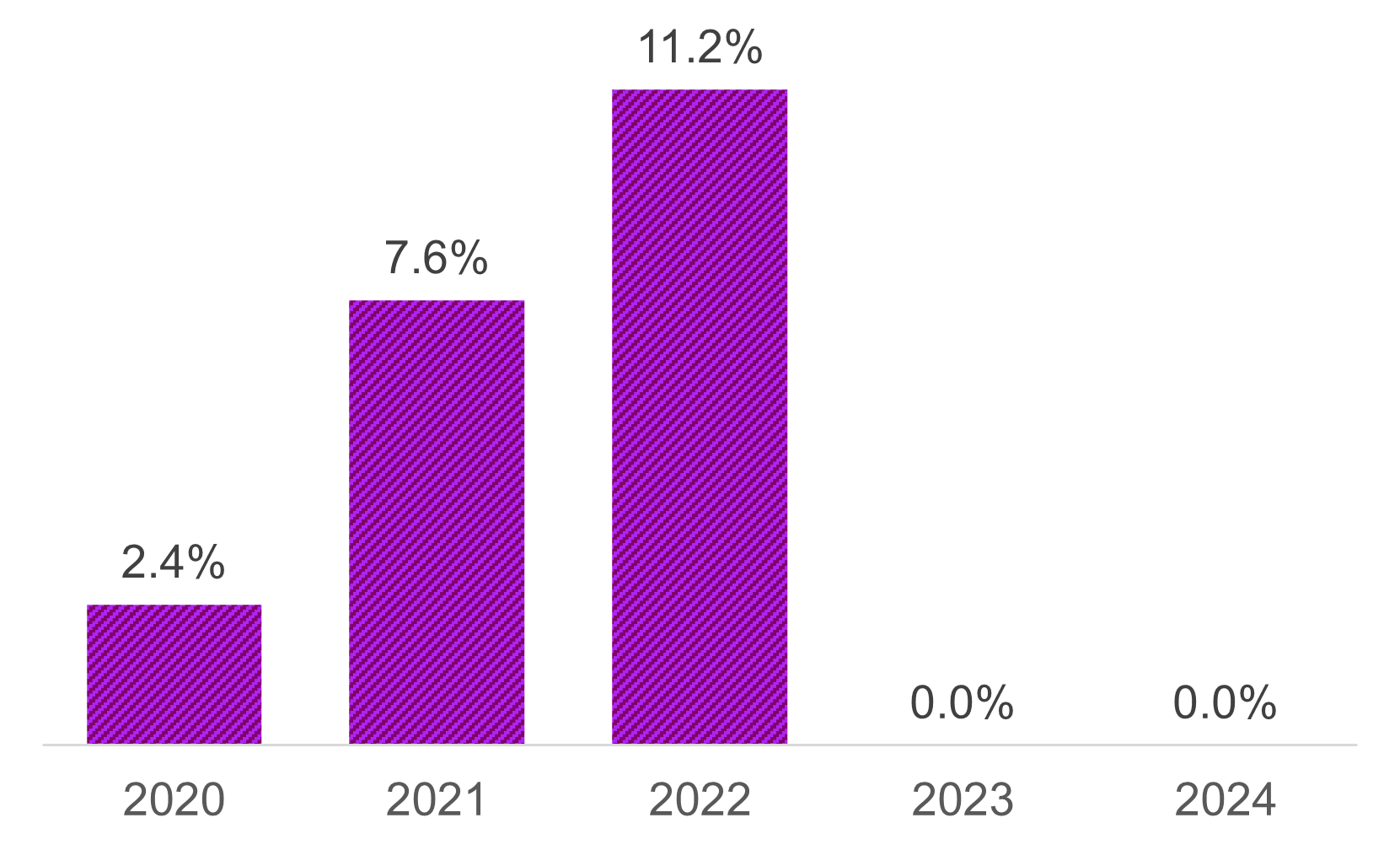
Median and mean gender pay gap in hourly pay (for all staff)
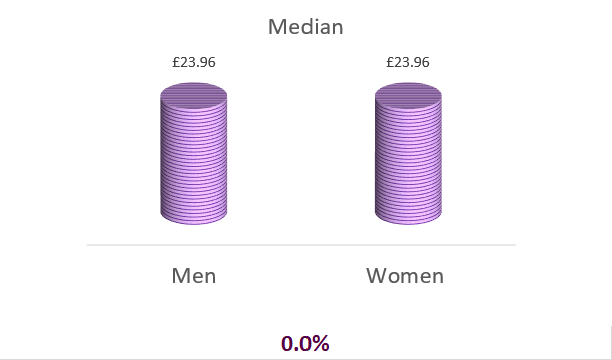
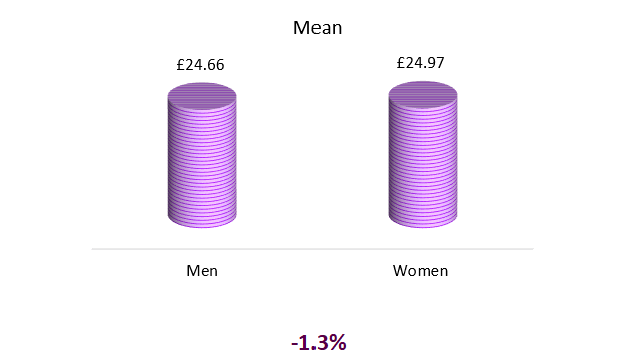
This figure looks at the hourly rate of pay for all staff (full-time and part-time) by gender, it is the high-level indicator of earning power.
The high-level gender pay gap is same as last year at 0%. This suggests the stabilisation associated with the pay reform (implemented in February 2023) has been embedded. The median hourly rates for both men and women now sit at the middle spine point of Grade 4 within the new salary scale.
The mean pay gap is -1.3%, a reduction of 0.9% on the 2022-23 rate. The median GPG for all Scotland as reported by the Scottish Government using ONS data is 9.2%.
Gender, grade and working pattern
| Grade | Men F/T | Men P/T | Women F/T | Women P/T |
|---|---|---|---|---|
| 2 | 73 | 5 | 71 | 18 |
| 3 | 39 | 7 | 53 | 17 |
| 4 | 64 | 7 | 62 | 21 |
| 5 | 40 |
3 | 48 | 13 |
| 6 | 19 | 2 | 14 | 3 |
| 7 and above | 3 | 0 | 7 | 0 |
| Solicitors Office |
4 | 0 | 12 | 6 |
| 242 | 23 | 267 | 78 |
Gross pay for full-time staff by gender
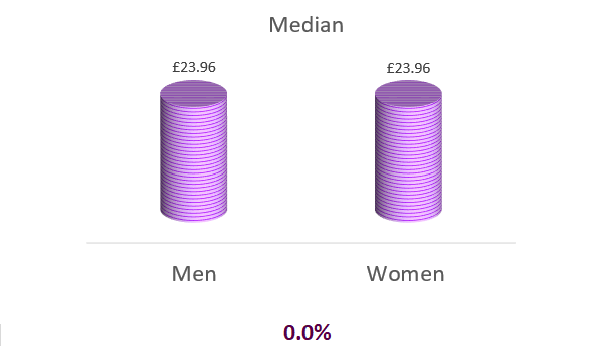

The gender pay difference for all full-time staff based on gross hourly rate has further reduced from £4.20 in the prior year to a nil rate this year, down from £5.09 in 2021/22.
This equates to a reduction from 21.7% in 2021/22 to 0.0% pay gap in line with the overall trend of reduction in pay gap.
For full-time staff the median pay scale point for men is now mid-point of grade 4 on the revised 2023 pay scale. This is a reduction on the result in prior year, where full-time men sat at the top of the revised pay scale. For full-time women the median point now also sits at the mid-point of the grade 4 scale (revised scale), up from the bottom scale point of grade 4 in prior year.
Gross pay for part-time staff by gender
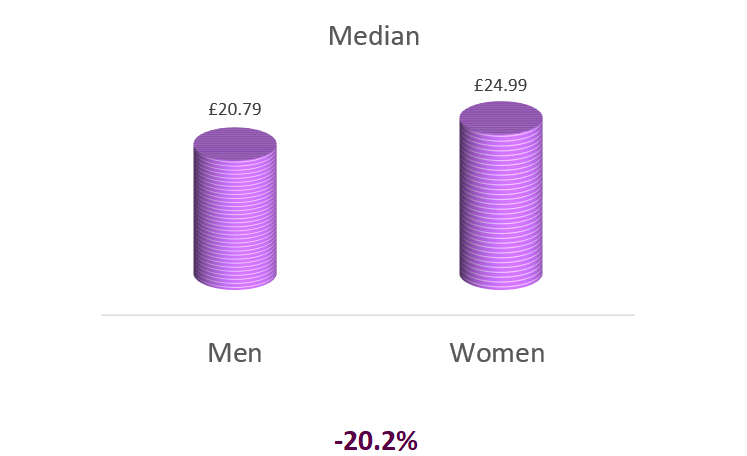
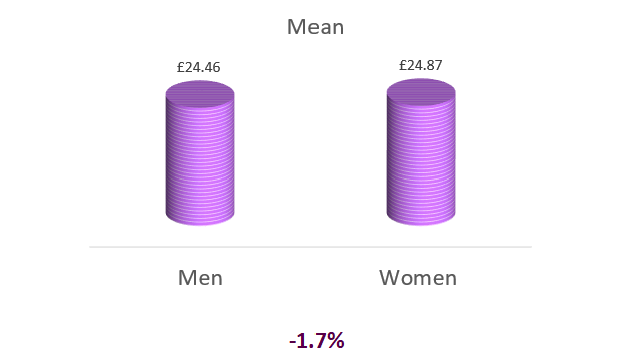
The gender pay gap for part-time men to part-time women has seen a further fluctuation this year. Where this moved from -34.2% in 2021 to 29.2% in 2022, there has been a small change this year from -25.2% in 2023 to -20.2% in the 2024 reporting year.
The net result here is that the median pay for part time women remains higher than that of part time men. Thus, though the pay reform has had an effect on this rate, there is continued stabilisation of the gap from 2021 trend when there was a significant change from the previous GPG (2020) of -1.3%.
The median spine point for part time men remains the top of Grade 3 (revised scale) in line with the result in the prior year, and the women’s median spine point for part-time staff is now between spine points 8 and 9, near the top of Grade 4 under the revised salary scale.
Median and mean exceptional contribution award (ECA) pay gap

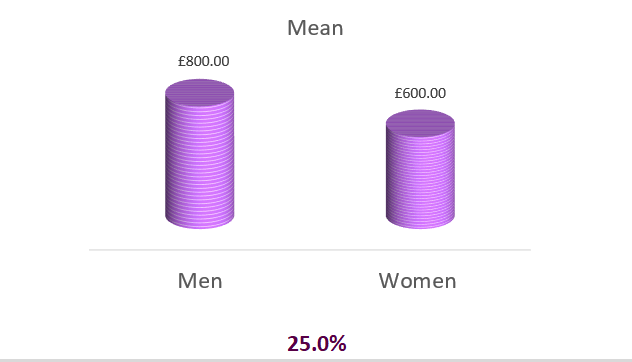
Proportion of staff receiving Exceptional Contribution Awards (ECA) by gender
| Gender | Staff receiving ECA | % of ECA | % in gender | % all staff | Total Staff |
|---|---|---|---|---|---|
| Men | 5 | 55.6% | 1.9% | 0.8% | 265 |
| Women | 4 | 44.4% | 1.2% | 0.7% | 345 |
| Total | 9 | 1.5% | 610 |
The SPCB does not have a ‘bonus culture’. The ECS provides for awards (ECAs) which are cash payments to reward staff for particularly demanding tasks. In this reporting year, there was a significant reduction in the number of ECAs compared to the previous year. This is likely as a result of the unusually high level of ECAs in the prior year which were awarded due to extraordinary projects.
As demonstrated in the table above, and in contrast with last year, men now account for the majority of ECAs. It is also notable, that as a proportion of headcount women are less likely to receive an ECA than their men. The maximum value exceptional contribution payment was this year made to a man, though the breadth of ECA values awarded remains relatively comparable.
The gap in value of ECA has seen a significant increase, with the rate this year sitting at 25.0% (using the mean measure) versus the percentage difference for 2023 which was reflected at 3.9%. It is worth considering the small dataset in this context, in that there were only a low number of ECAs awarded – this may account for the widening of the gap in terms of breadth of data points.
Proportion of men and women in each pay quartile
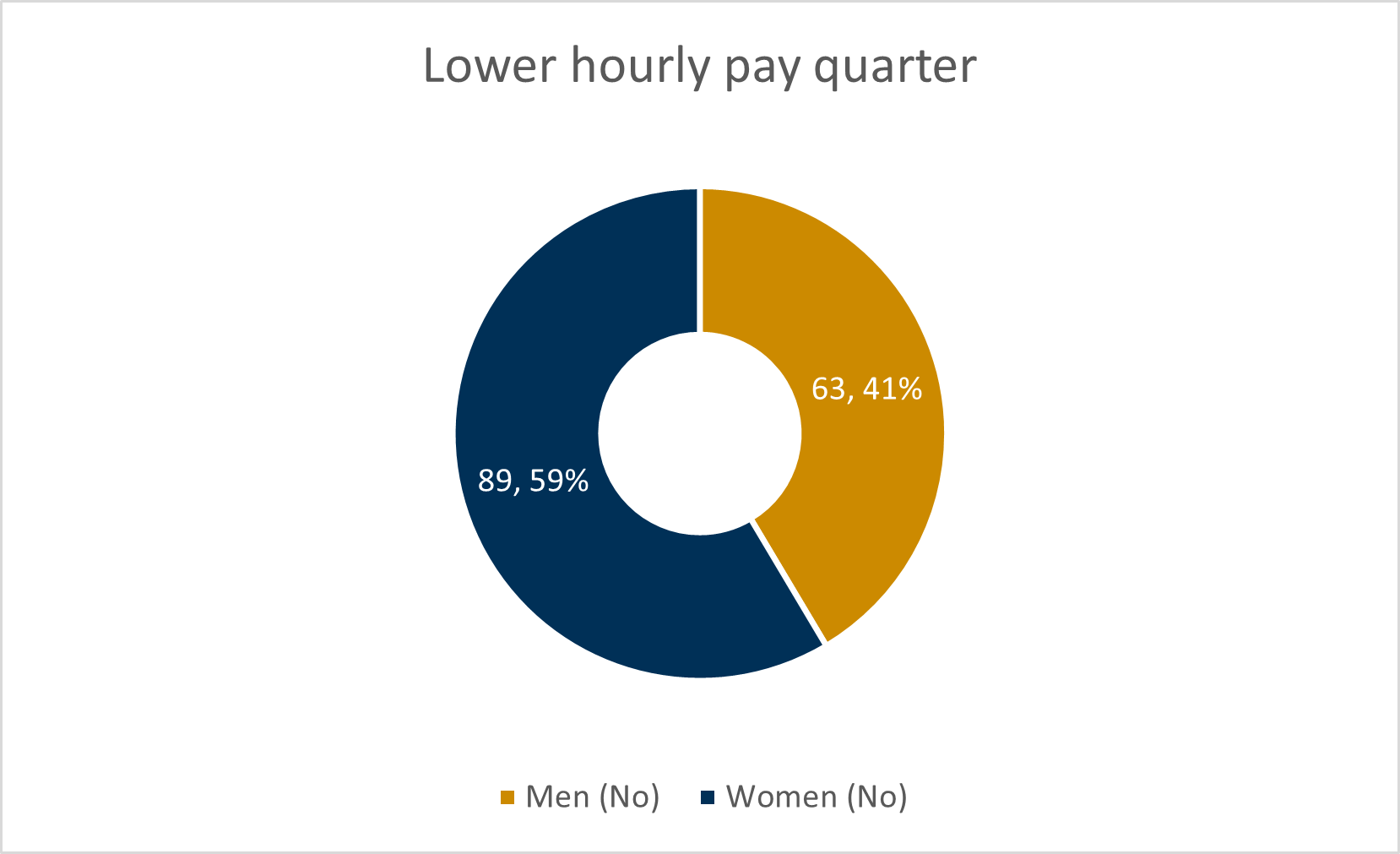
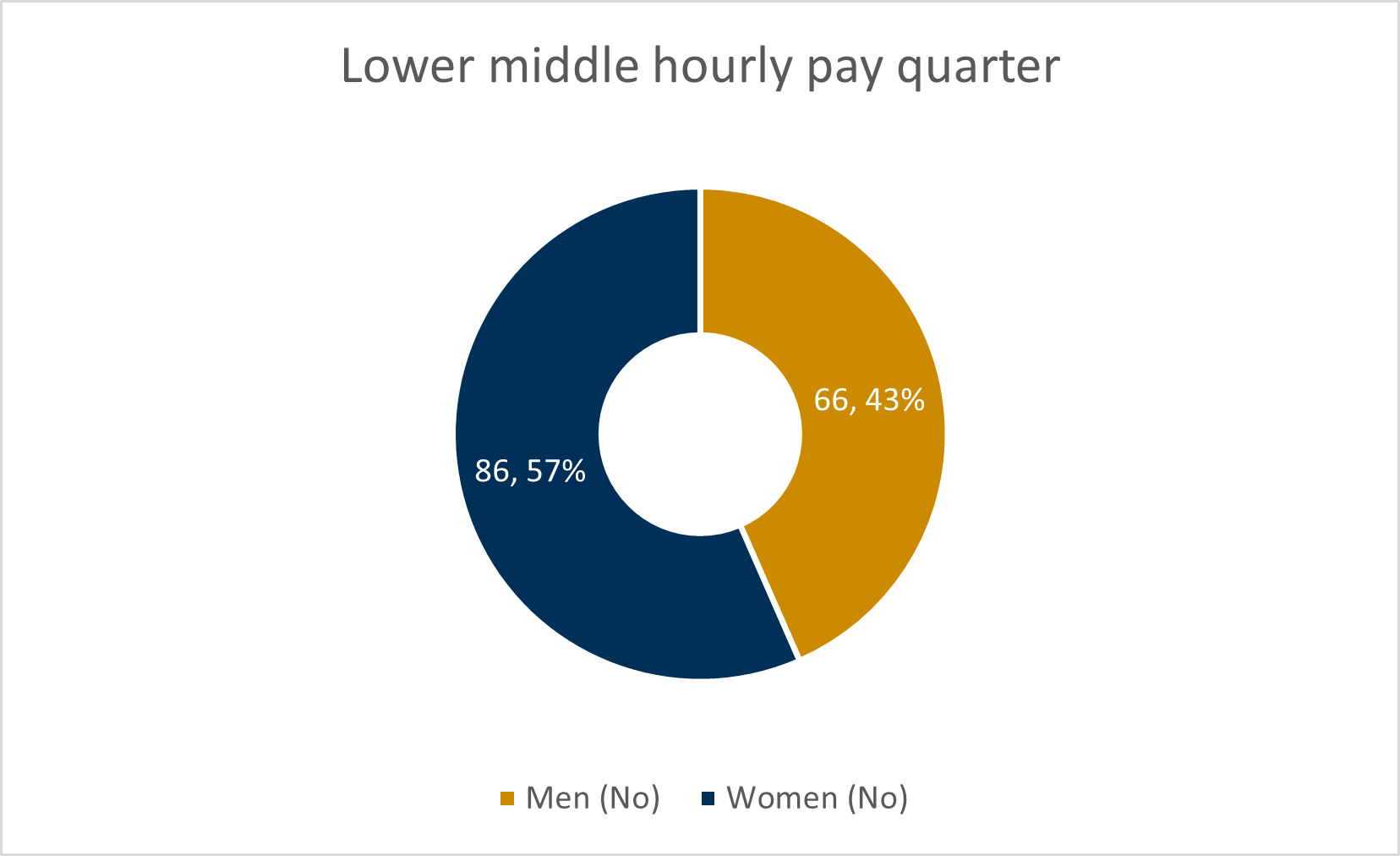
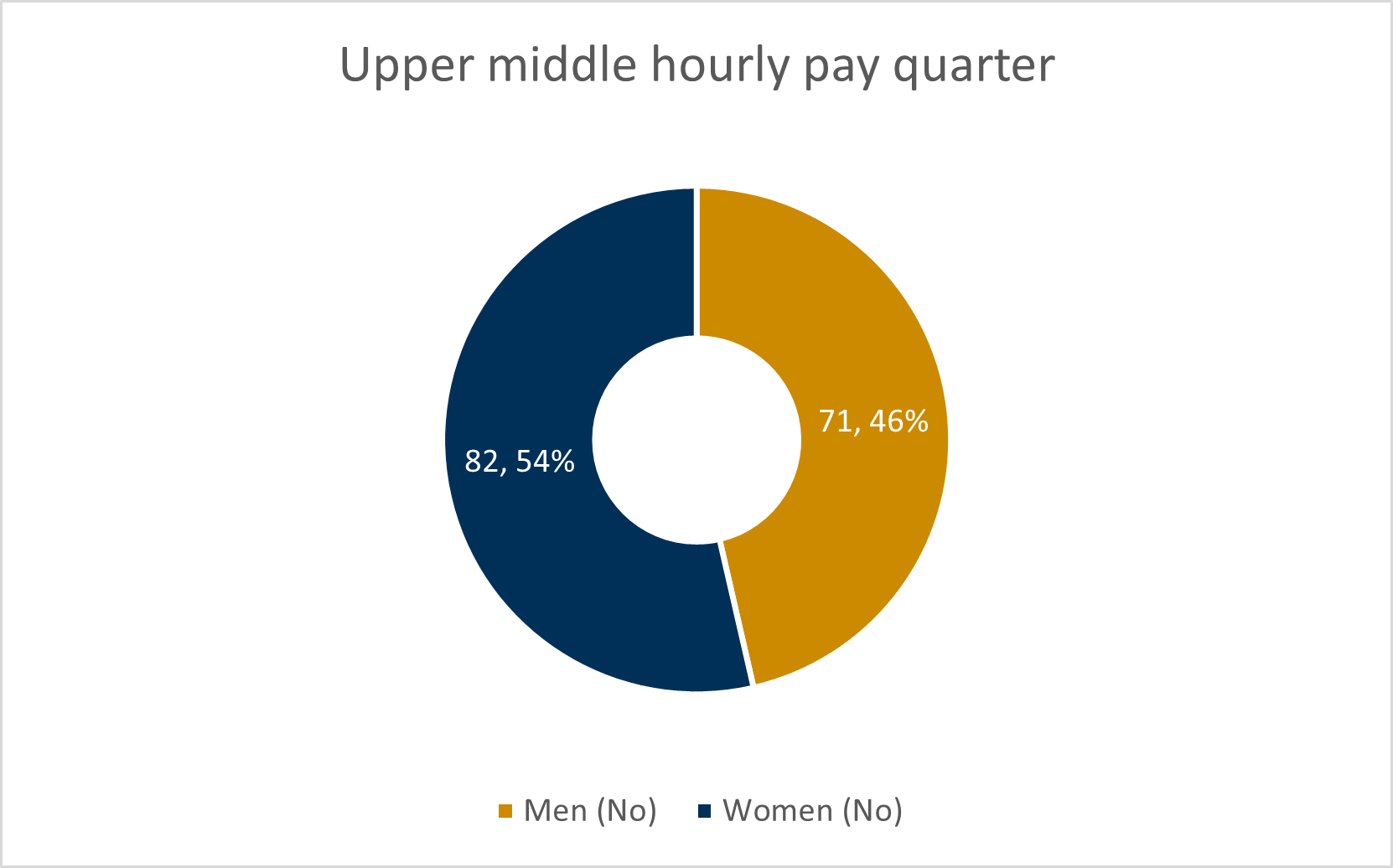
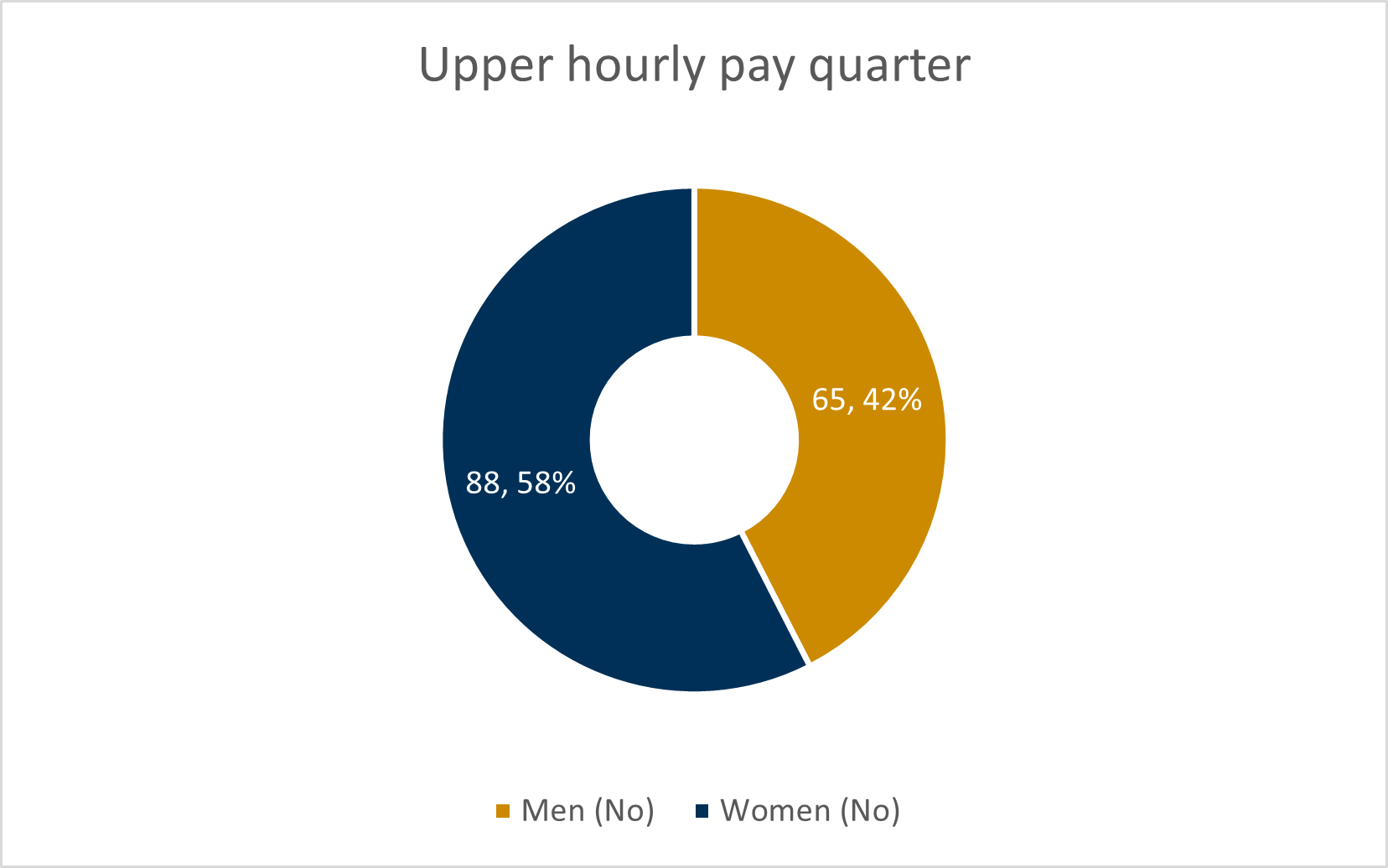
This measures the proportion of men and women in each quartile when divided into four groups ordered from lowest to highest pay. This demonstrates whether there is an overrepresentation of one gender within lower or higher paid jobs. The current SPCB staffing ratio is now 43:57 (men: women). All quartiles are within 5% of this range, however the first quartile which predominantly represents grades 2 and 3 has the biggest variance on the organisational ratio.
Notably, there is a slightly higher representation of women than the ratio for the full organisation within the lower quartile (circa 59%), and the upper quartile which reflects a headcount proportion rate for women of almost 1% above the organisational complement ratio.
Ethnicity Pay Gap
Ethnicity Pay Gap
Data tables available for download here (82KB Excel document)
Our Ethnicity Pay Gap measures the average difference in pay between all staff who have identified as Minority Ethnic and those who have identified as a White ethnic group. We have placed our staff into two cohorts due to the relatively small dataset size.
In reporting on the Ethnicity Pay Gap we have considered the previous UK Government calculating advice and have aligned with this where we have sufficient data to do so. We will keep the calculation method under review for any new advice from the current UK government and for opportunities to make calculations on a more granular level.
The following analysis is based on an ethnicity declaration rate of 54% (a significant reduction in available data from that reflected in the prior reporting year).
Annual changes in median Ethnicity Pay Gap
| 2023/24 | 2022/23 | 2021/22 | 2020/21 | 2019/20 |
|---|---|---|---|---|
| 17.3% | 20.1% | 30.1% | 27.6% | 21.3% |
Median and mean ethnicity pay gap in hourly pay (for all staff)
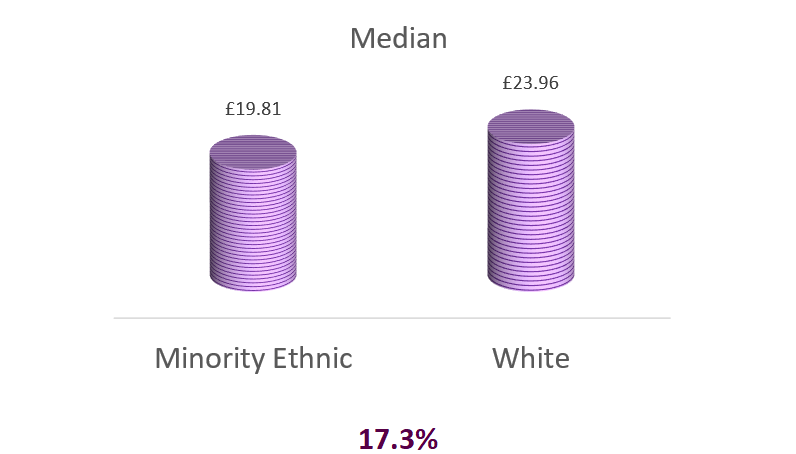
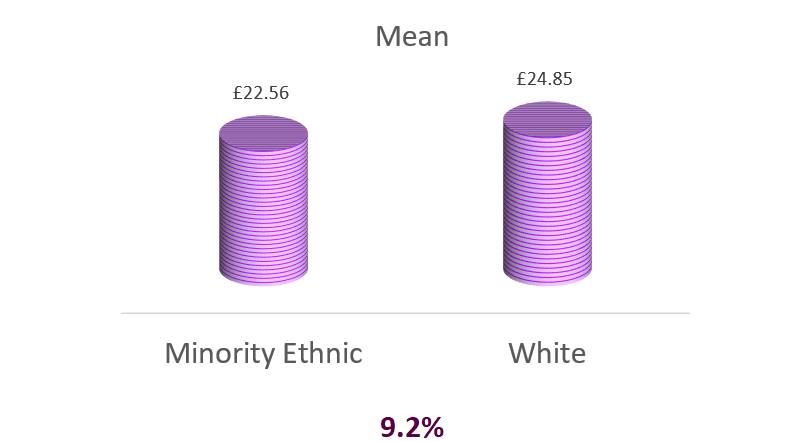
This figure looks at the hourly rate of pay for all staff (full-time and part-time) by ethnicity, it is the high-level indicator of earning power. The ethnicity pay gap has decreased from 20.1% in 2023 to 17.3% in 2024 (a reduction of 2.8%). This is the lowest rate since the commencement of ethnicity pay gap reporting in 2019.
In 2024 the median salary point for minority ethnic staff is close to the top of the Grade 3 scale (mid-way between points 4 and 5 of the salary scale). The median point for White staff is the middle of the Grade 4 scale (point 7 on the salary scale).
Ethnicity and pay quartiles
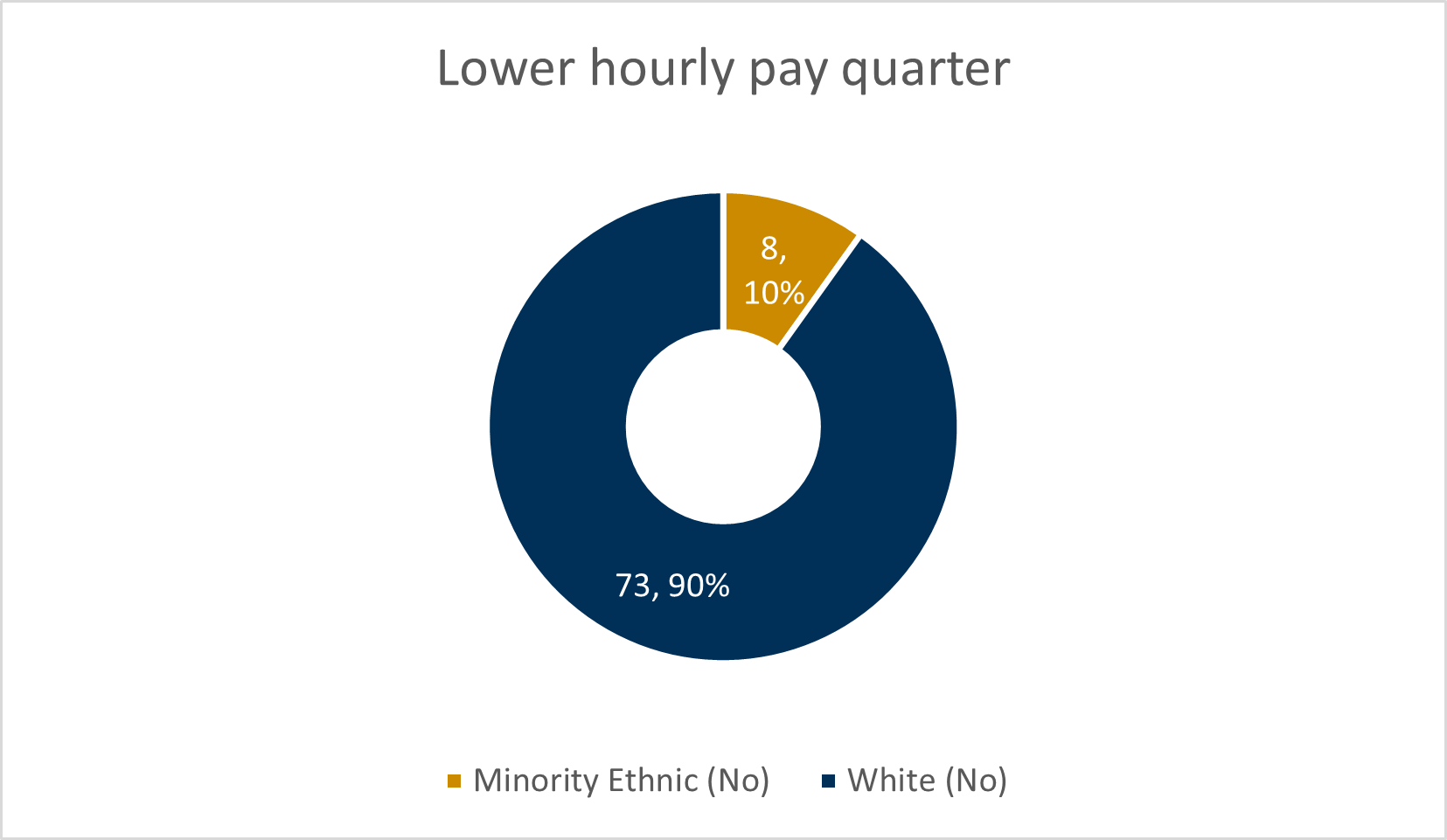
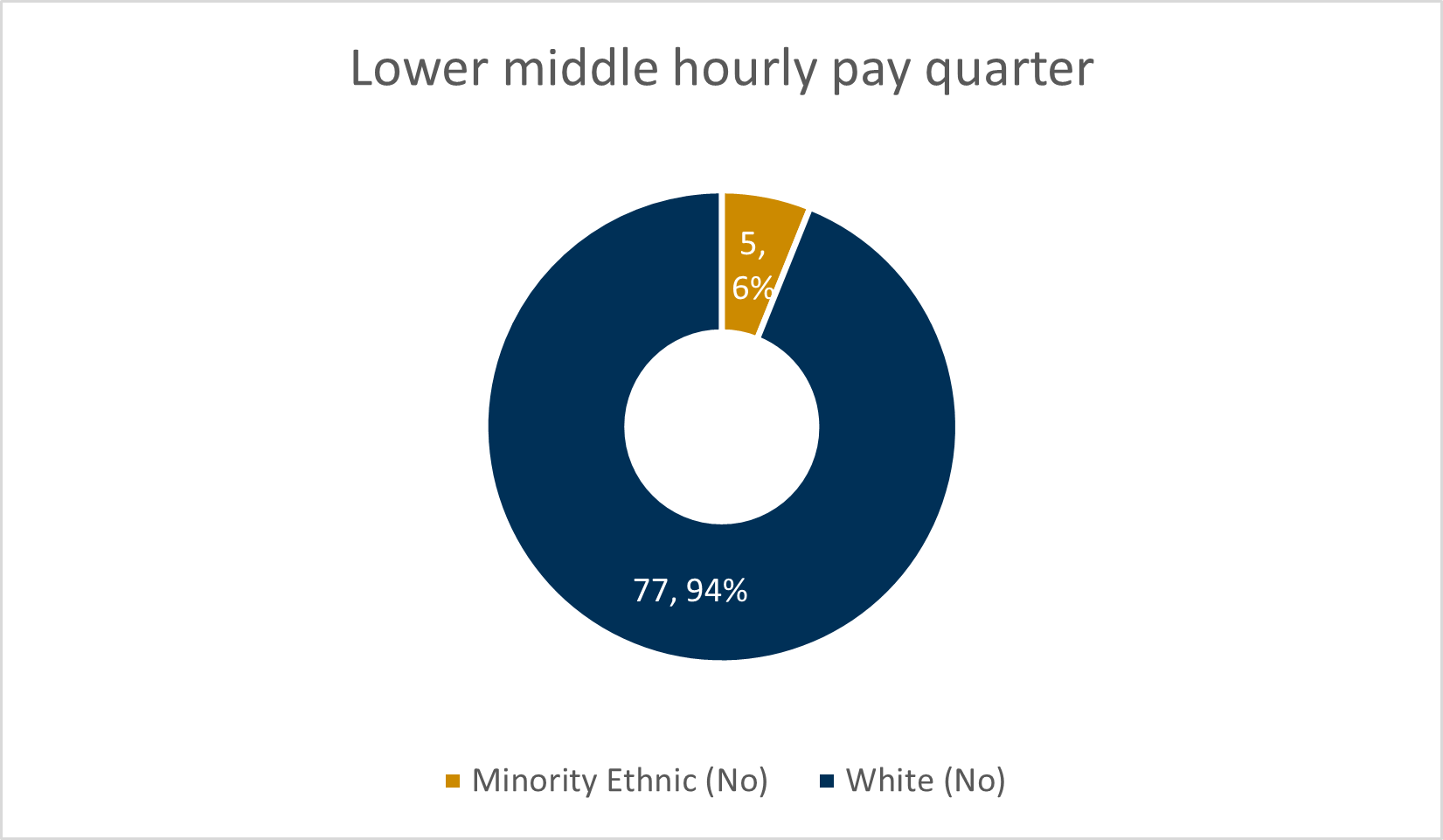
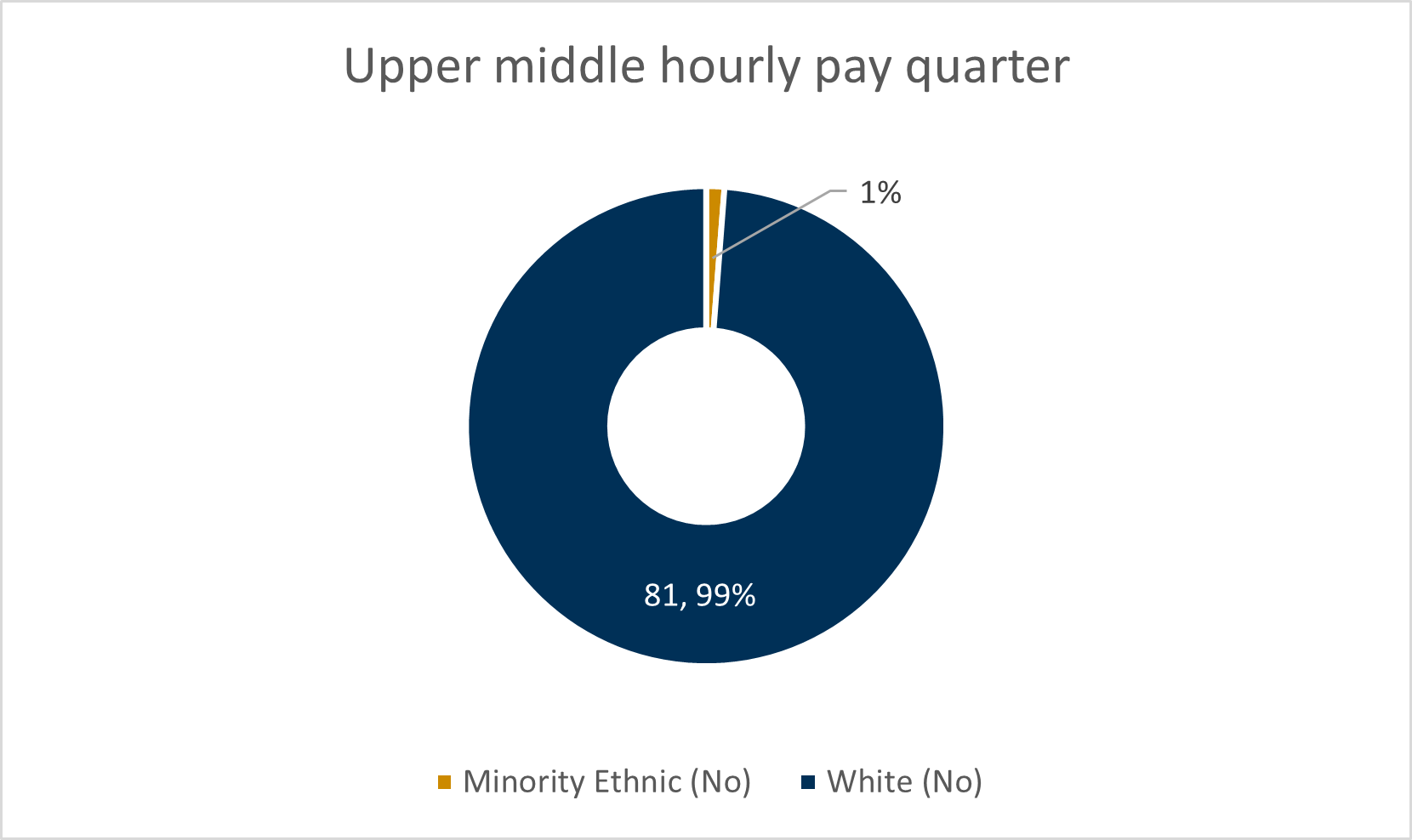
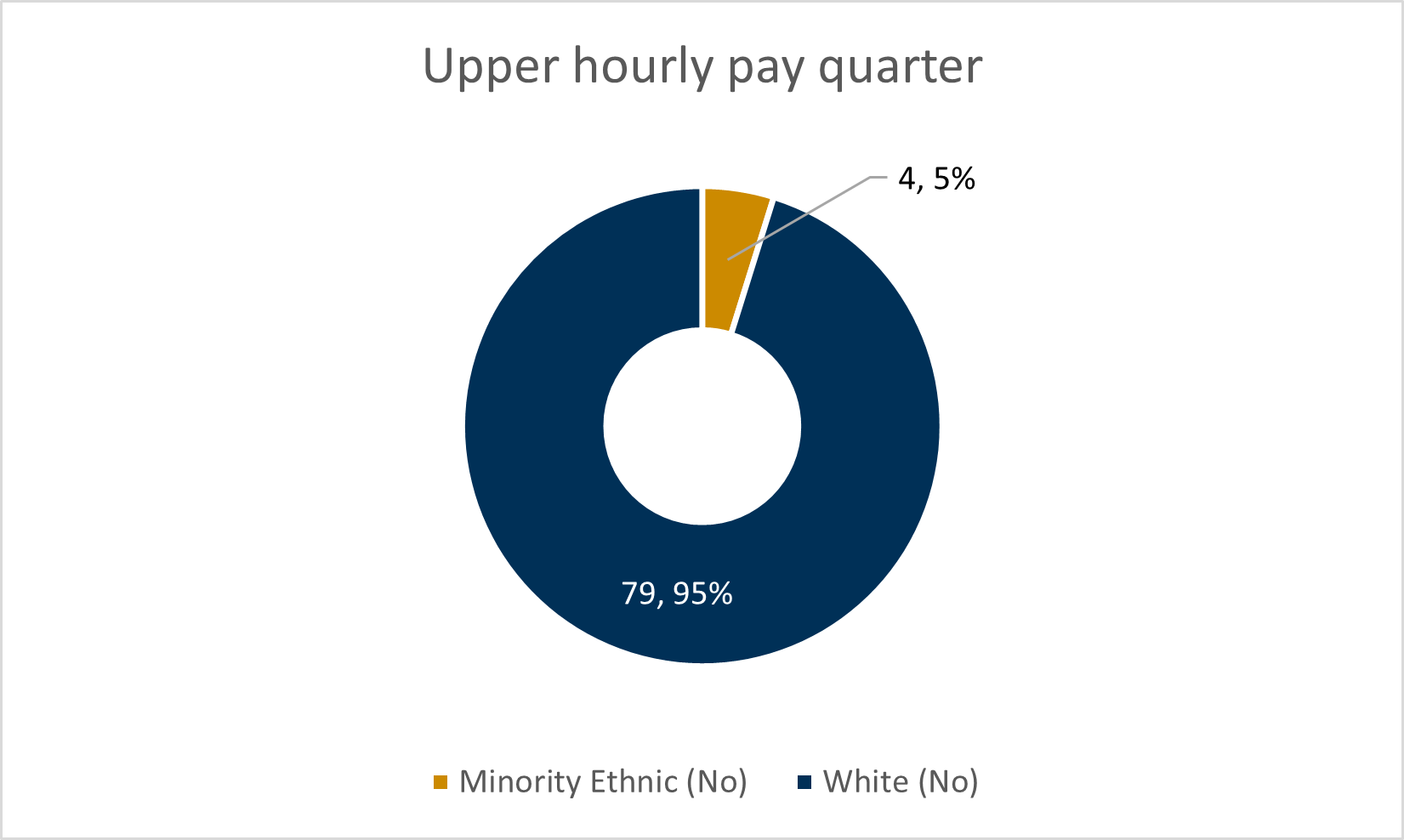
Based on the available data, there is a higher representation of Minority Ethnic staff in the lower two quartiles than the organisational ratio, which is consistent with 67% of Minority Ethnic staff being employed in grades 1-3. This is in line with the findings for the prior year.
There has, however, been an increase in representation at the top quartile (circa 0.5%), though this is in the context of reduced representation across the group (which may in turn be attributed to the reduction in available data).
Disability Pay Gap
Disability Pay Gap
Data tables available for download here (82KB Excel document)
The Disability Pay Gap measures the difference in pay between all staff who have declared a disability, and those staff who have not declared a disability.
There is not an agreed format for disability pay gap reporting at this time, we have therefore made the decision to align with some of the measures required for Gender Pay Gap reporting.
For comparison the most recently available UK median disability pay gap reported by the Office for National Statistics (ONS) is 12.7% (ONS, 2023).
Annual changes in median disability pay gap
| 2023/24 | 2022/23 | 2021/22 | 2020/21 | 2019/20 |
|---|---|---|---|---|
| 13.2% | 4.8% | 13.4% | 7.6% | 2.4% |
Median and mean disability pay gap in hourly pay (for all staff)
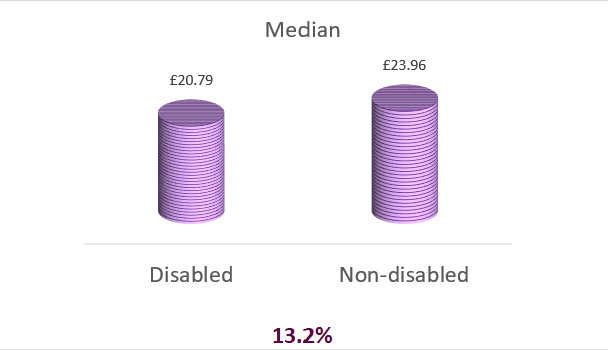

Disability and pay quartiles
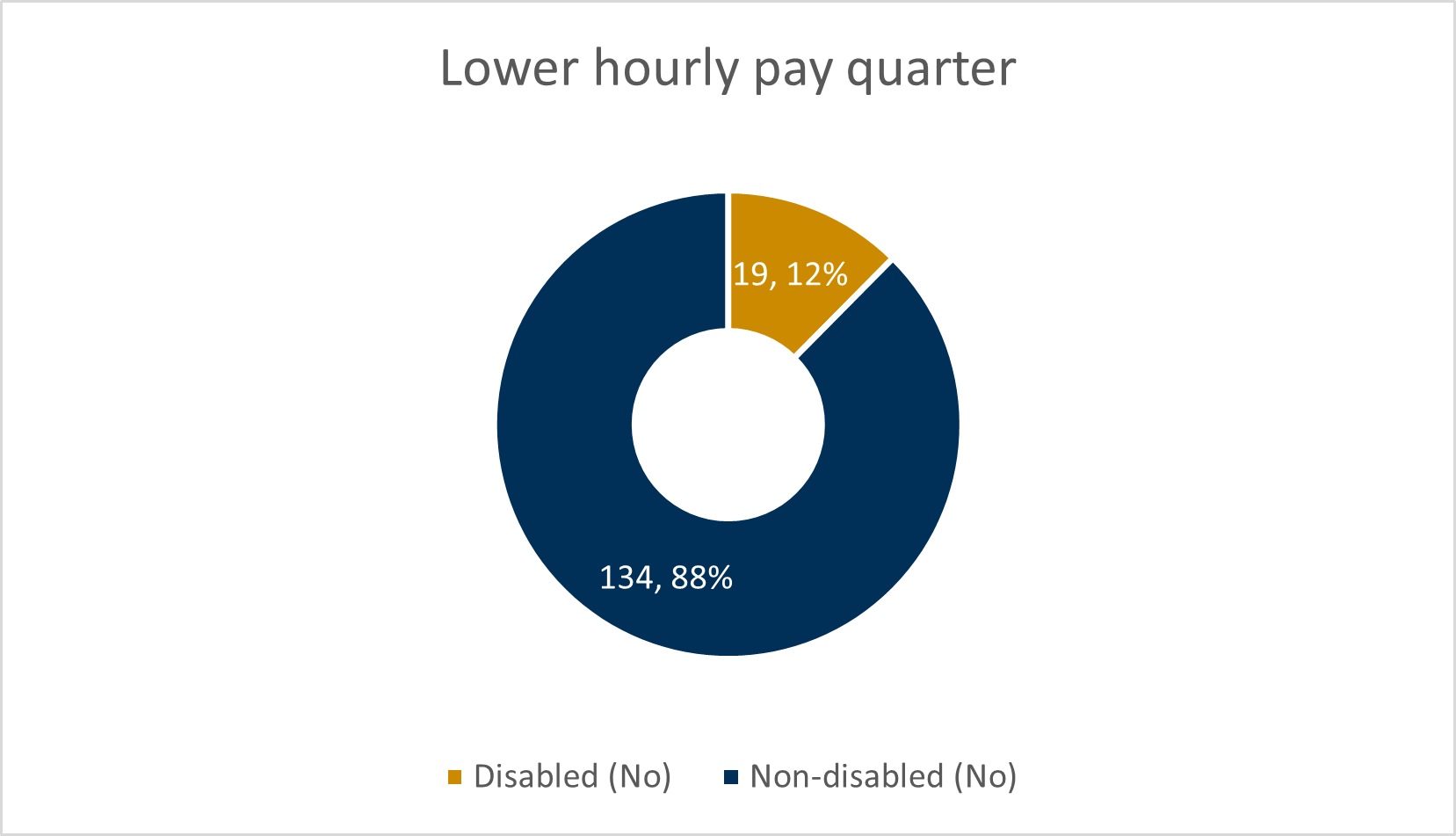
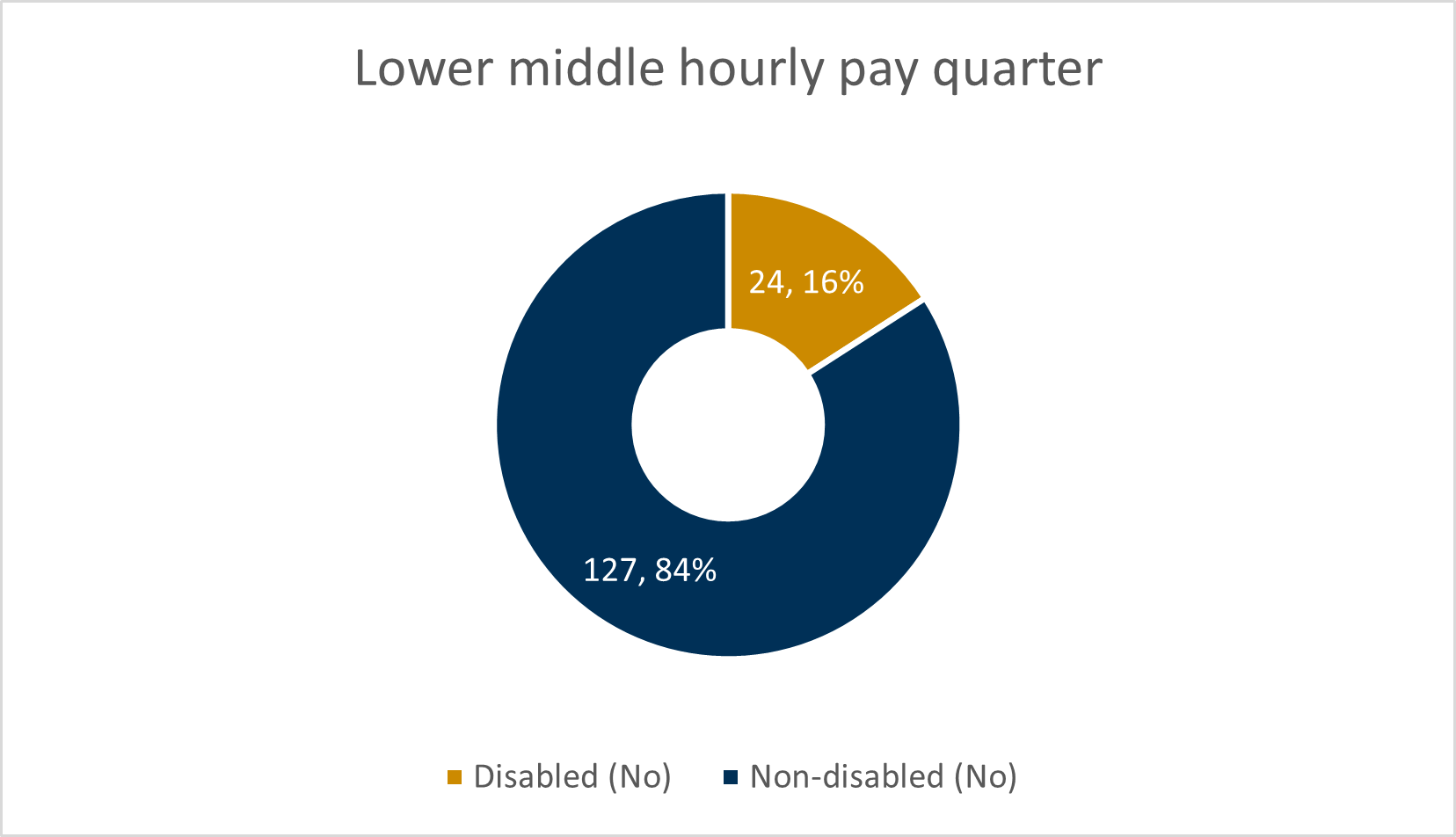
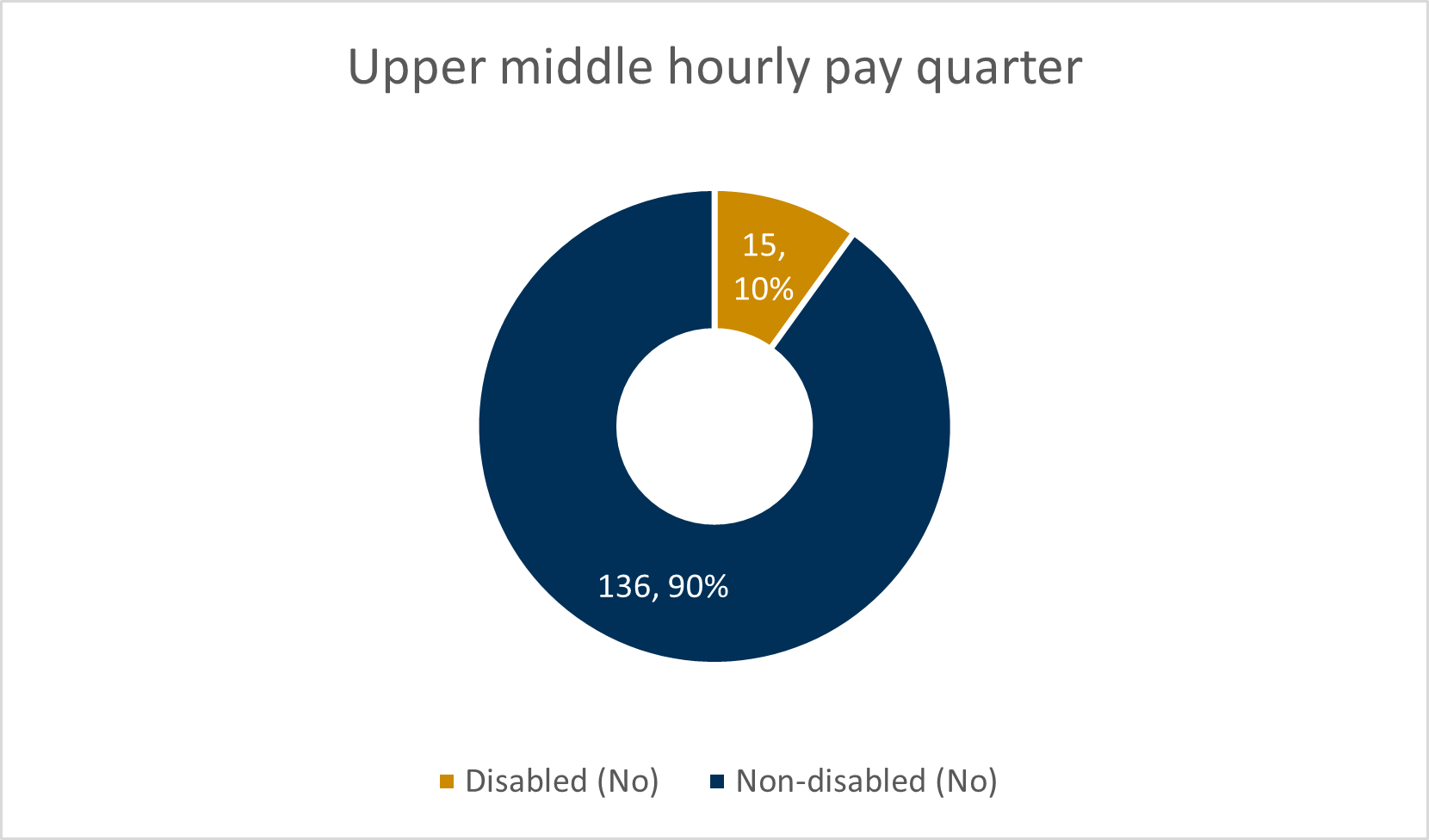
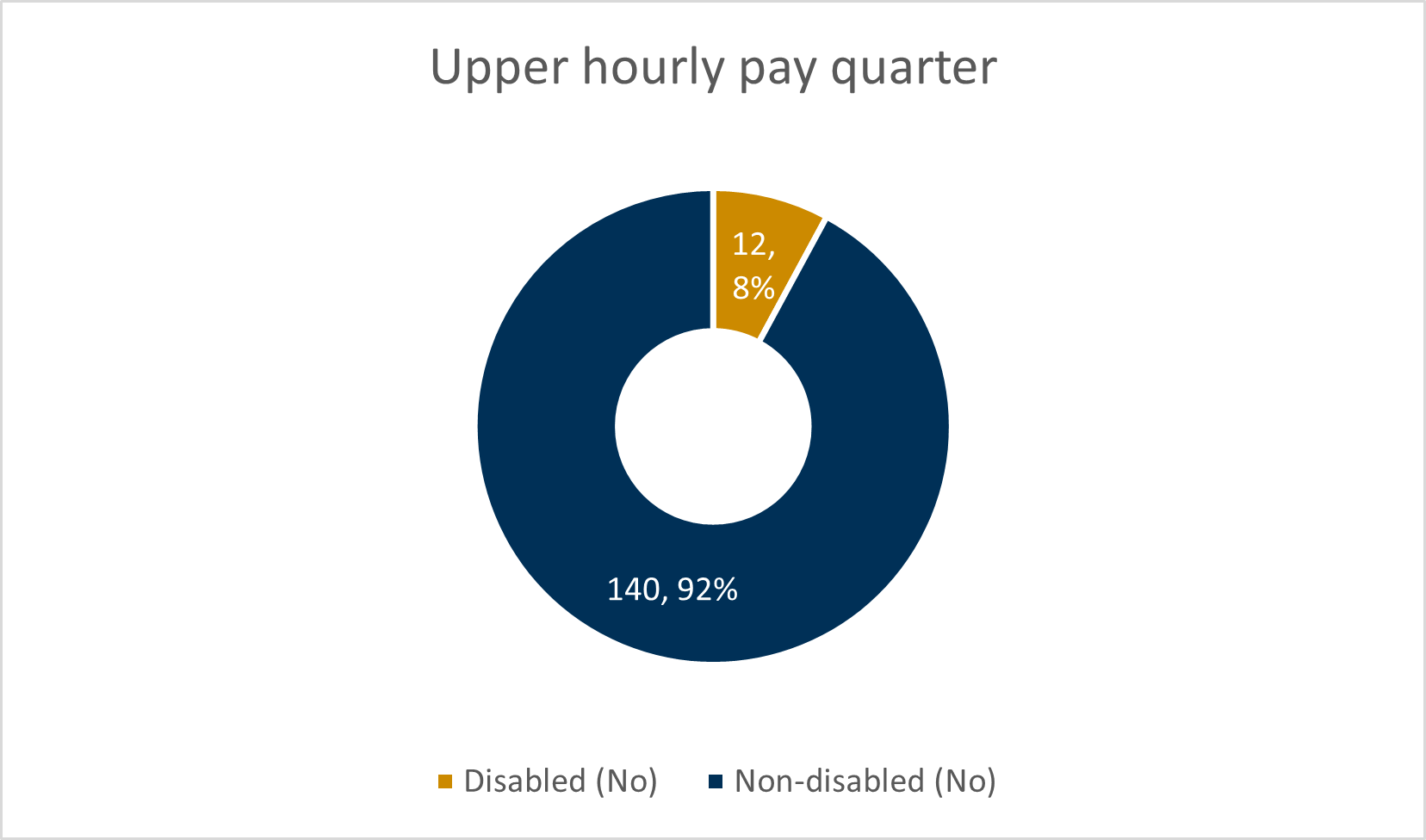
The median spine salary point for staff who have declared a disability is the top of Grade 3 (point 6). The equivalent figure for staff who have declared they don’t have a disability is salary point 8, which is the middle of Grade 4.
Disabled staff are significantly represented in the lower quartiles. 61.4% of all staff who have declared a disability are represented in these two quartiles.
The increased pay gap from the previous year has been caused by a 4% increase from the previous year in the proportion of staff in the lower middle pay quartile along with reduced proportionality of staff in the upper middle and upper pay quartiles.
LGB+ Pay Gap
LGB+ Pay Gap
Data tables available for download here (82KB Excel document)
There is not an agreed format for LGB+ pay gap reporting at this time, we have therefore made the decision to align the measures to those required for Gender Pay Gap reporting.
The data is limited by the LGB+ declaration rates from the staff group. As with the Ethnicity Pay gap, we have placed our staff into two cohorts due to the relatively small dataset size.
Annual changes in median LGB+ pay gap
| 2023/24 | 2022/23 | 2021/22 |
|---|---|---|
| 20.1% | 16.1% | 9.8% |
Median and mean LGB+ pay gap in hourly pay (for all staff)
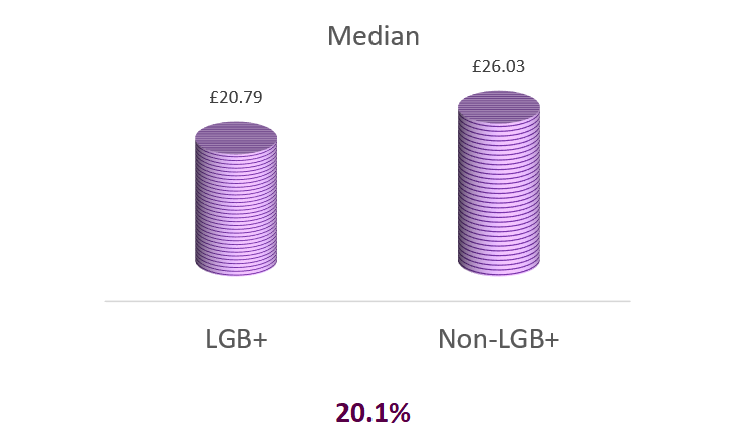

LGB+ and pay quartiles
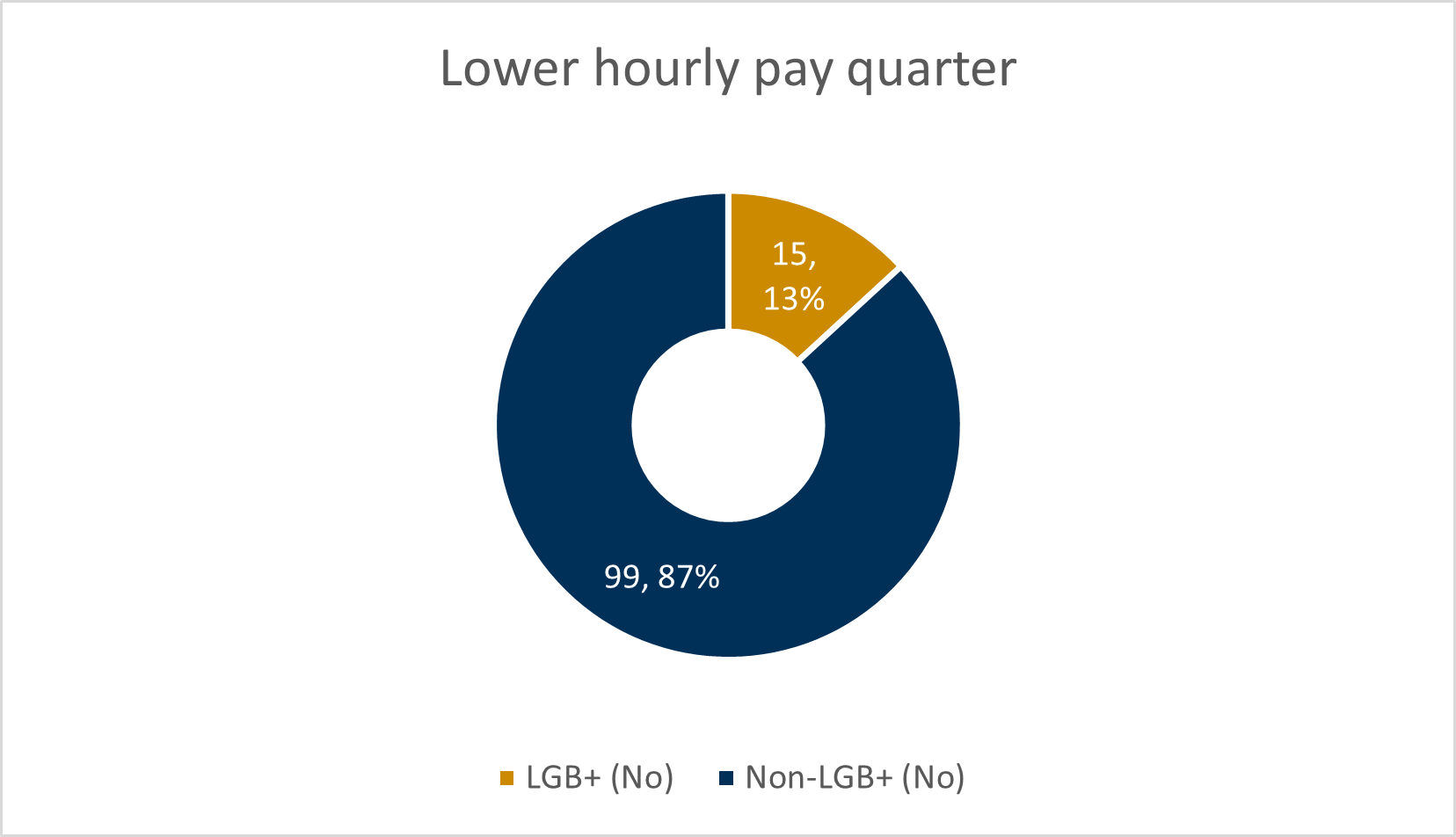
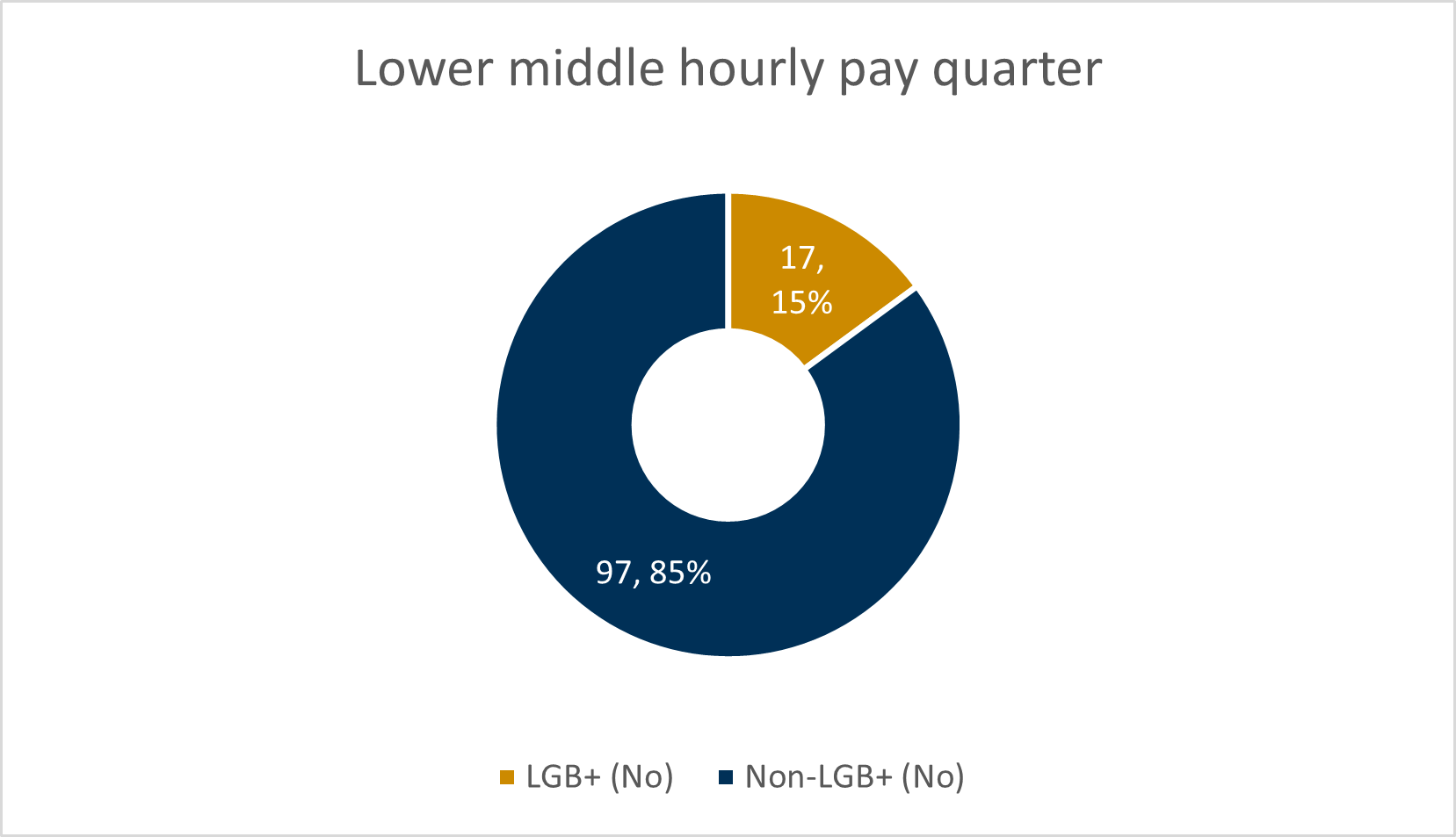

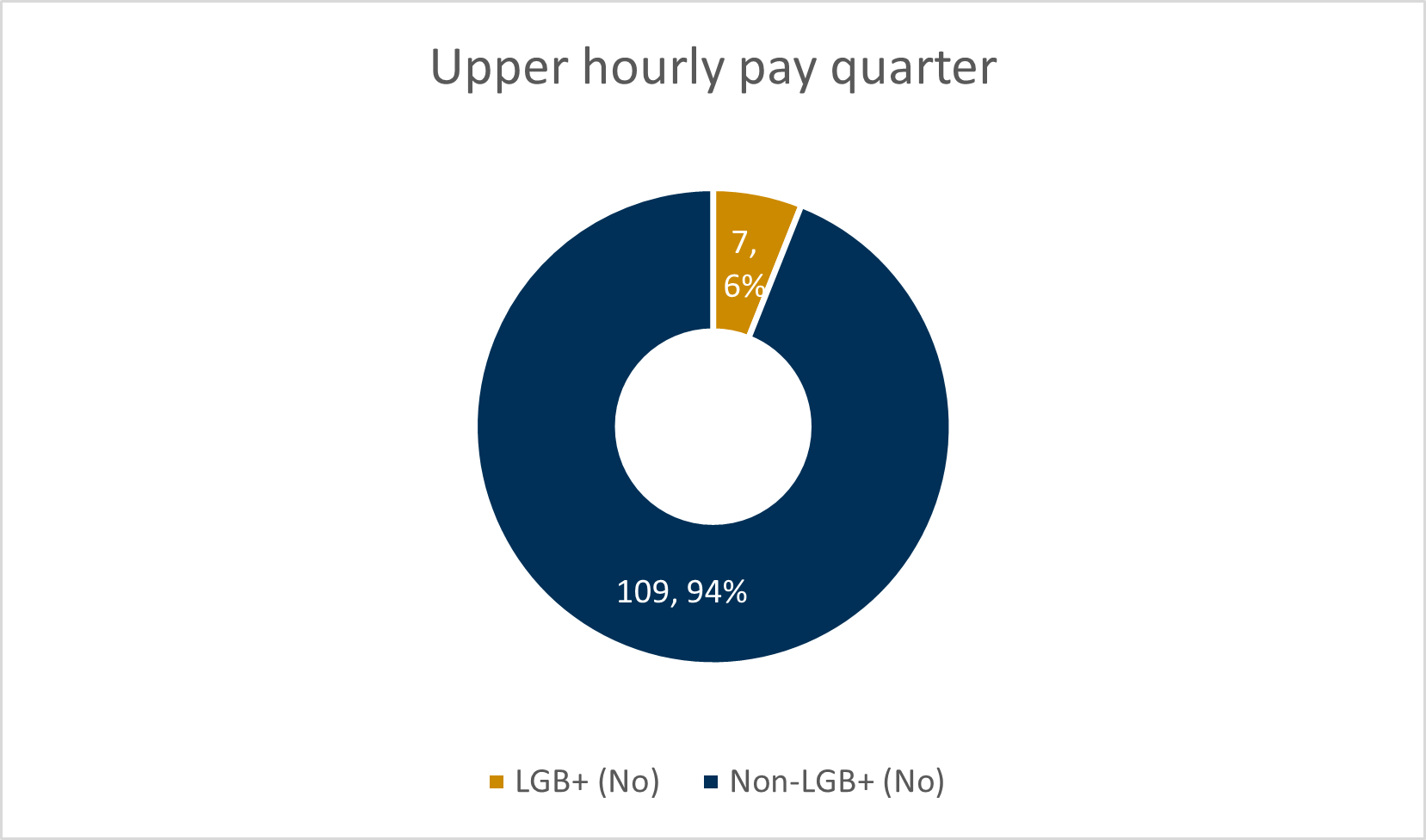
The median spine salary point for LGB+ staff is the top of Grade 3 (point 6). The equivalent figure for heterosexual staff is salary point 9, the top of Grade 4.
LGB+ colleagues are over represented in the lower two quartiles. The split is 64% in the lower two quartiles and 36% in the upper two quartiles.
Equal pay
Equal Pay
Data tables available for download here (82KB Excel document)
Equal Pay and the Gender Pay Gap are not the same. Equal pay means that men and women are paid the same amount for doing work of equal value unless any difference in pay can be justified.
Annual median FTE salary by grade and gender (grade 7 and above combined)
| Grade | Women | Men | Difference | % difference |
|---|---|---|---|---|
| 1 | £0.00 | £0.00 | £0.00 | 0.0% |
| 2 | £31,318.01 | £31,318.01 | £0.00 | 0.0% |
| 3 | £40,000.00 | £40,000.00 |
£0.00 | 0.0% |
| 4 | £46,091.00 | £50,079.01 | £3,988.01 | 8.0% |
| 5 | £59,624.99 |
£63,147.01 | £3,522.02 | 5.6% |
| 6 | £79,671.99 | £79,671.99 |
£0.00 | 0.0% |
| 7 and above | £97,671.99 | £97,671.99 | £0.00 | 0.0% |
| Solicitors |
£59,575.00 |
£85,875.00 | £26,300.00 | 30.6% |
Hourly pay breakdown by grade and gender
Median
| Grade | Women | Men | Difference | % difference |
|---|---|---|---|---|
| 1 | £0.00 | £0.00 | £0.00 | 0.0% |
| 2 | £16.28 | £16.28 | £0.00 | 0.0% |
| 3 | £20.79 | £20.79 |
£0.00 | 0.0% |
| 4 | £26.03 | £26.03 | £0.00 | 0.0% |
| 5 | £32.82 |
£32.82 | £0.00 | 0.0% |
| 6 | £41.41 | £41.41 |
£0.00 | 0.0% |
| 7 and above | £50.77 | £50.77 | £0.00 | 0.0% |
| Solicitors |
£34.92 |
£44.63 | £9.71 | 21.8% |
Mean
| Grade | Women | Men | Difference | % difference |
|---|---|---|---|---|
| 1 | £0.00 | £0.00 | £0.00 | 0.0% |
| 2 | £16.12 | £16.10 | -£0.02 | -0.1% |
| 3 | £20.22 | £20.05 |
-£0.17 | -0.8% |
| 4 | £25.50 | £25.46 | -£0.04 | -0.1% |
| 5 | £32.01 |
£31.97 | -£0.04 | -0.1% |
| 6 | £40.49 | £40.01 |
-£0.48 | -1.2% |
| 7 and above | £53.64 | £63.82 | £10.17 | 15.9% |
| Solicitors |
£35.15 |
£41.99 | £6.83 | 16.3% |
As demonstrated in the tables above the median hourly rate of pay for men and women is equal for all grades on the main SPCB pay scale.
The whole Solicitors office has been placed into two cohorts men/women due to the numbers in the Office. Staff doing the same role are paid equally. The data provided demonstrates a gender pay gap difference.
In line with the findings last year, there is a difference in the hourly rate for solicitors where men are employed between points 48 and 55, on the revised scale, whereas a greater variance exists in the job roles of women.
This is accounted for in the staffing ratio 17:83 of staff employed within the solicitor’s office (inclusive of an increase, proportionately, in men and associated minor decrease in women this year).
The median point for men within the solicitor’s office remains at solicitor team leader level, whereas for women in the solicitor’s office the median point continues to fall at the solicitor grade level which demonstrates why the gap is greater in this office compared to the main pay grade scale.
Staff Survey 2023
Staff Survey 2023
Our staff survey was held from mid-September to mid-October 2023.
The survey once again included questions asking staff to respond about their mental health and wellbeing and the inclusivity of the culture at the Parliament. Survey results when compared to the survey conducted in 2021 have either improved or stayed the same across all sections of the survey.
The survey results produce a wellbeing risk index which allows us to compare ourselves to other organisations. We scored 26% (compared to 34% in 2021) on the wellbeing risk index, which is categorised as "good" and compares to 40% for other public sector bodies and 39% for all companies. When asked 82% of our staff reported that they had good to excellent mental health.
In 2021, when asked if the Parliament is committed to creating a diverse and inclusive workplace, 78% of respondents agreed. In this survey staff were asked to respond whether they ‘trust that we take inclusion and diversity seriously here’, again 78% of staff agreed.
We will next be progressing work on taking forward the actions from the Positive About Mental Health and Wellbeing Policy Implementation Plan.
The health and wellbeing of all our colleagues is a priority for the Parliament and an integral part of our culture and values. We want our workplace to be supportive of the mental health and wellbeing of everyone. Where we can end the stigma around mental health and can support each other.
Key to the success of embedding our workplace mental health and wellbeing aims is the recognition that each of us – managers, staff, MSPs as employers and their staff – understand our roles and responsibilities and that we work together to achieve the SPCB’s aim to support a workplace environment that promotes the good mental health and wellbeing of all colleagues.
Response rates
| 2023 | 2021 | |
|---|---|---|
| Response rate | 75% |
72% |
| Engagement score | 73% |
71% |
Wellbeing and inclusion
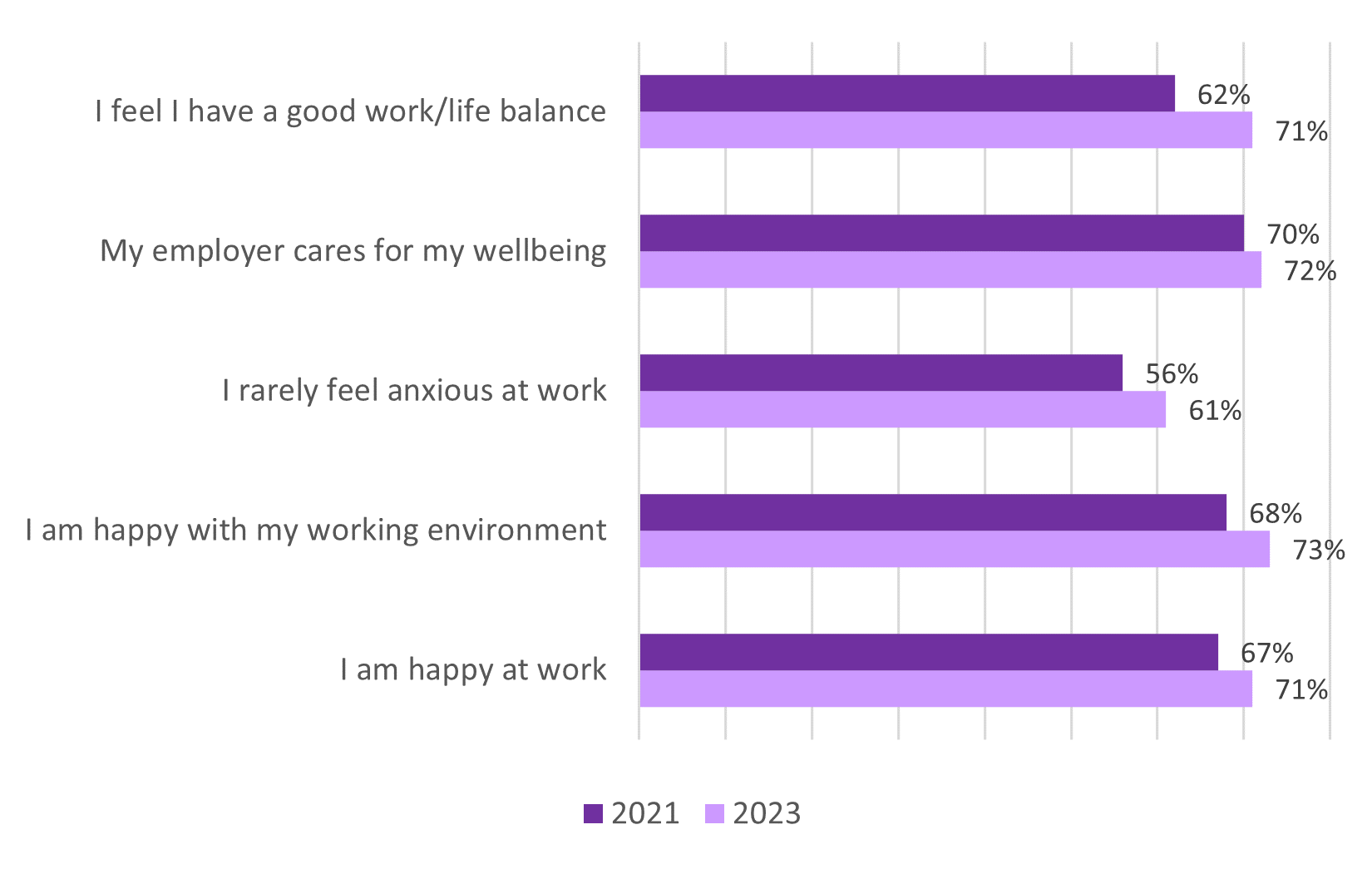
| 2023 | 2021 | |
|---|---|---|
| I am happy at work | 71% | 67% |
| I am happy with my working environment | 73% | 68% |
| I rarely feel anxious at work | 61% | 56% |
| My employer cares for my wellbeing | 72% | 70% |
| I feel I have a good work/life balance | 71% | 62% |
| I trust that we take inclusion and diversity seriously here | 78% | n/a |
Physical and mental wellbeing
| How would you rate your physical wellbeing? | How would you rate your mental wellbeing? | |
|---|---|---|
| Excellent | 8% | 6% |
| Very good | 28% | 23% |
| Good | 49% | 53% |
| Poor | 13% | 16% |
| Very poor | 1% | 3% |
Our future actions
Our future actions
In the next year (1 April 2024 to 31 March 2025) we will continue with our actions in support of the aims of the Session 6 People and Culture Strategy. We will:
- Continue to regularly review our workforce data to measure whether the Delivery Plan is supporting us to achieve our diversity and inclusion aims.
- Review our progress against the recommendations made in the external inclusion maturity assessment.
- Conduct a review of our recruitment processes using intersectional analysis to assess whether there are any barriers preventing specific groups of people from succeeding.
- Commence work in 2025 on the development of our Equity, Diversity and Inclusion Strategy for 2026 – 31.
- Develop a Race Strategy including setting out our plan to tackle barriers in the workplace for minority ethnic people and our activities aimed at reducing the ethnicity pay gap
- Progress with the review of our Dignity at Work Policy in line with our aim to address negative impacts of power imbalances and ensure all colleagues are treated with dignity and respect.
- Set up Engagement Networks for our colleagues to provide improved opportunity for involvement in decision making and being better informed about why decisions are made.
- Develop a Learning Framework – As a values led organisation, we must nurture a culture where learning and development (L&D) is prioritised. We will invest in L&D to maximise on return in investment for optimal organisational performance. Our aims will be to deliver a great colleague experience, to attract and retain diverse talent.
- Provide workshops and peer support for colleagues to learn about and share experiences of the perimenopause and menopause including measures that enable a supportive workplace.
- Progress the Scottish Parliament’s application to be re-accredited as a Disability Confident Leader in 2025.
- Engagement campaign with our staff about the importance of providing their information to support our planning to meet our diversity and inclusion aims.
- Conduct follow up to the diversity data gathering and reporting review conducted in 2023.